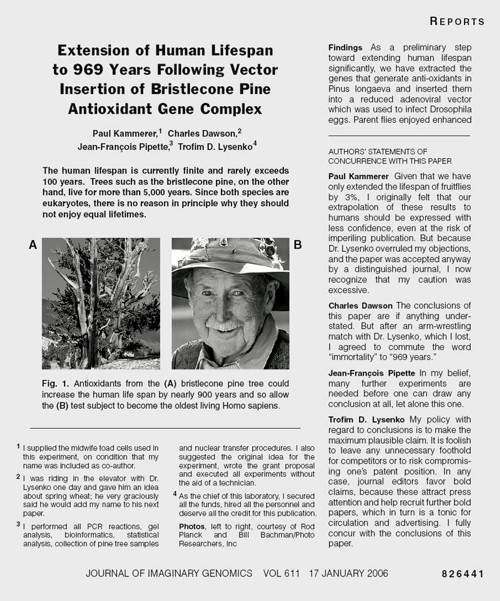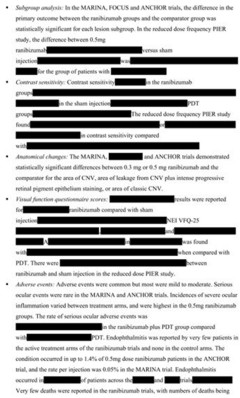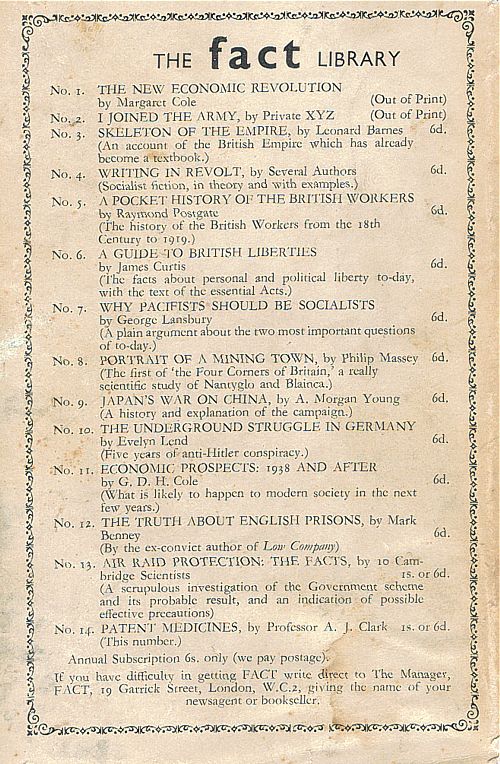Big Pharma
This is a web version of a review of Peter Gotzsche’s book. It appeared in the April 2014 Healthwatch Newsletter. Read the whole newsletter. It has lots of good stuff. Their newsletters are here. Healthwatch has been exposing quackery since 1989. Their very first newsletter is still relevant.
|
Most new drugs and vaccines are developed by the pharmaceutical industry. The industry has produced huge benefits for mankind. But since the Thatcherite era it has come to be dominated by marketing people who appear to lack any conscience. That’s what gave rise to the Alltrials movement. It was founded in January 2013 with the aim of ensuring that all past and present clinical trials are registered before they start and that and their results are published The industry has been dragged, kicking and screaming, towards a new era of transparency, with two of the worst offenders, GSK and Roche, now promising to release all data. Let’s hope this is the beginning of real open science. |
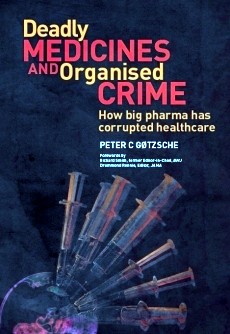
|
This version is not quite identical with the published version in which several changes were enforced by Healthwatch’s legal adviser. They weren’t very big changes, but here is the original.
Deadly Medicines and Organised Crime
By Peter Gøtzsche, reviewed by David Colquhoun
Published by Radcliffe Publishing Ltd on 1 August 2013. RRP £24.99 (320 pages, paperback)
ISBN-10: 1846198844 ISBN-13: 978-1846198847
As someone who has spent a lifetime teaching pharmacology, this book is a bitter pill to swallow. It makes Goldacre’s Bad Pharma seem quite mild.
In fairness, the bits of pharmacology that I’ve taught concern mostly drugs that do work quite well. Things like neuromuscular blocking agents, local anaesthetics, general anaesthetics, anticoagulants, cardiac glycosides and thyroid drugs all do pretty much what is says on the label.
Peter Gøtzsche is nothing if not evidence man. He directs the Nordic Cochrane group, and he talks straight. His book is about drugs that don’t work as advertised. There is no doubt whatsoever that the pharmaceutical industry has behaved very badly indeed in the last couple of decades. You don’t have to take my word for it, nor Peter Gotzche’s, nor Ben Goldacre’s. They have told us about it themselves. Not voluntarily of course, but in internal emails that have been revealed during court proceedings, and from whistleblowers.
Peter Rost was vice president marketing for the huge pharmaceutical company, Pfizer, until he was fired after the company failed to listen to his complaints about illegal marketing of human growth hormone as an anti-ageing drug. After this he said:
“It is scary how many similarities there are between this industry and the mob. The mob makes obscene amounts of money, as does this industry. The side effects of organized crime are killings and deaths, and the side effects are the same in this industry. The mob bribes politicians and others, and so does the drug industry … “
The pharmaceutical industry is the biggest defrauder of the US federal government under the False Claims Act. Roche led a cartel that, according to the US Justice Department’s antitrust division, was the most pervasive and harmful criminal antitrust conspiracy ever uncovered. Multibillion dollar fines have been levied on all of the big companies (almost all in the USA, other countries have been supine), though the company’s profits are so huge they are regarded as marketing expenses.
It’s estimated that adverse effects of drugs kill more people than anything but cancer and heart disease, roughly half as many as cigarettes. This horrifying statistic is announced at the beginning of the book, though you have to wait until Chapter 21 to find the data. I’d have liked to see a more critical discussion of the problems of causality in deciding why someone died, which are just as big as those in deciding why somebody recovered. Nevertheless, nobody seems to deny that the numbers who are killed by their treatments are alarmingly high.
Gøtzsche’s book deals with a wide range of drugs that don’t do what it says on the label, but which have made fortunes because of corruption of the scientific process. These include non-steroidal anti-inflammatory drugs (NSAIDs), an area described as “a horror story filled with extravagant claims, bending of the rules, regulatory inaction, . . .”. Other areas where there has been major misbehaviour include diabetes (Avandia), and the great Tamiflu scandal. and the great Tamiflu scandal. It took five years of pressure before Roche released the hidden data about Tamiflu trials. It barely works. Goldacre commented “government’s Tamiflu stockpile wouldn’t have done us much good in the event of a flu epidemic”
But the worst single area is psychiatry.
Two of the chapters in the book deal with psychiatry. Nobody has the slightest idea how the brain works (don’t believe the neuroscience hype) or what causes depression or psychosis. Treatments are no more than guesses and none of them seems to work very well.
The problems with the SSRI antidepressant, paroxetine (Seroxat in UK, Paxil in USA) were brought to public attention, not by a regulator, but by a BBC Panorama television programme. The programme revealed that a PR company, which worked for GSK, had written
"Originally we had planned to do extensive media relations surrounding this study until we actually viewed the results. Essentially the study did not really show it was effective in treating adolescent depression, which is not something we want to publicise."
This referred to the now-notorious study 329. It was intended to show that paroxetine should be recommended for adolescent depression. The paper that eventually appeared in 2001 grossly misrepresented the results. The conclusions stated “Paroxetine is generally well tolerated and effective for major depression in adolescents”, despite the fact that GSK already knew this wasn’t true. The first author of this paper was Martin Keller, chair of psychiatry at Brown University, RI, with 21 others.
But the paper wasn’t written by them, but by ghost authors working for GSK. Keller admitted that he hadn’t checked the results properly.
That’s not all. Gøtzsche comments thus.
“Keller is some character. He double- billed his travel expenses, which were reimbursed both by his university and the drug sponsor. Further, the Massachusetts Department of Mental Health had paid Brown’s psychiatry department, which Keller chaired, hundreds of thousands of dollars to fund research that wasn’t being conducted. Keller himself received hundreds of thousands of dollars from drug companies every year that he didn’t disclose.”
His department received $50 million in research funding. Brown University has never admitted that there was a problem. It still boasts about this infamous paper
The extent of corruption at Brown University rivals the mob.
The infamous case of Richard Eastell at Sheffield university is no better. He admitted in print to lying about who’d seen the data. The university did nothing but fire the whistleblower.
Another trial, study 377, also showed that paroxetine didn’t work. GSK suppressed it.
“There are no plans to publish data from Study 377” (Seroxat/Paxil Adolescent Depression. Position piece on the phase III clinical studies. GlaxoSmithKline document. 1998 Oct.)
Where were the regulatory agencies during all this? The MHRA did ban use of paroxetine in adolescents in 2003, but their full investigation didn’t report until 2008. It came to much the same conclusions as the TV programme six years earlier about the deceit. But despite that, no prosecution was brought. GSK got away with a deferential rap on the knuckles.
Fiona Godlee (editor of the BMJ, which had turned down the paper) commented
“We shouldn’t have to rely on investigative journalists to ask the difficult questions”
Now we can add bloggers to that list of people who ask difficult questions. The scam operated by the University of Wales, in ‘validating’ external degrees was revealed by my blog and by BBC TV Wales. The Quality Assurance Agency came in only at the last moment. Regulators regularly fail to regulate.
|
Despite all this, the current MHRA learning module on SSRIs contains little hint that SSRIs simply don’t work for mild or moderate depression. Neither does the current NICE guidance. Some psychiatrists still think they do work, despite there being so many negative trials. |
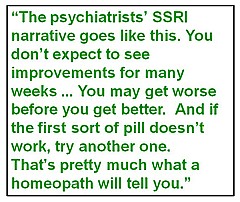 |
The psychiatrists’ narrative goes like this. You don’t expect to see improvements for many weeks (despite the fact that serotonin uptake is stopped immediately). You may get worse before you get better. And if the first sort of pill doesn’t work, try another one. That’s pretty much identical with what a homeopath will tell you. The odds are that its meaning is, wait a while and you’ll get better eventually, regardless of treatment.
It’s common to be told that they must work because when you stop taking them, you get worse. But, perhaps more likely, when you stop taking them you get withdrawal symptoms, because the treatment itself caused a chemical imbalance. Gøtzsche makes a strong case that most psychiatric drugs do more harm than good, if taken for any length of time. Marcia Angell makes a similar case in The Illusions of Psychiatry.
Gøtzsche will inevitably be accused of exaggerating. Chapter 14 ends thus.
“Merck stated only 6 months before it withdrew Vioxx that ‘MSD is fully committed to the highest standards of scientific integrity, ethics, and protection of patient’s wellbeing in our research. We have a tradition of partnership with leaders in the academic research community. Great. Let’s have some more of such ethical partnerships. They often kill our patients while everyone else prospers.
Perhaps Hells Angels should consider something similar in their PR: We are fully committed to the highest standards of integrity, ethics and protection of citizens’ well- being when we push narcotic drugs. We have a tradition of partnership with leaders in the police force”.
But the evidence is there. The book has over 900 references. Much of the wrongdoing has been laid bare by legal actions. I grieve for the state of my subject.
The wrongdoing by pharma is a disgrace.
The corruption of universities and academics is even worse, because they are meant to be our defence against commercial corruption.
All one can do is to take consolation from the fact that academics, like Gøtzsche and Goldacre, and a host of bloggers, are the people who are revealing what’s wrong. As a writer for the business magazine, Fortune, said
“For better or worse, the drug industry is going to have to get used to Dr. Peter Rost – and others like him.”
At a recent meeting I said that it was tragic that medicine, the caring profession, was also the most corrupt (though I’m happy to admit that other jobs might be as bad if offered as much money).
At present there is little transparency. There is no way that I can tell whether my doctor is taking money from pharma, data are still hidden from public scrutiny by regulatory agencies (which are stuffed with people who take pharma money) as well as by companies. Governments regard business as more important than patients. In the UK, the Government continued promotion of the fake bomb detector for many years after they’d been told it was fake. Their attitude to fake medicines is not much different. Business is business, right?
One side effect of the horrific corruption is that it’s used as a stick by the alternative medicine industry. That’s silly of them, because their business is more or less 100% mendacious marketing of ineffective treatments. At least half of pharma products really do work.
Fines are useless. Nothing will change until a few CEOs, a few professors and a few vice-chancellors spend time in jail for corruption.
Read this book. Get angry. Do something.
Follow-up
[This an update of a 2006 post on my old blog]
The New York Times (17 January 2006) published a beautiful spoof that illustrates only too clearly some of the bad practices that have developed in real science (as well as in quackery). It shows that competition, when taken to excess, leads to dishonesty.
More to the point, it shows that the public is well aware of the dishonesty that has resulted from the publish or perish culture, which has been inflicted on science by numbskull senior administrators (many of them scientists, or at least ex-scientists). Part of the blame must attach to "bibliometricians" who have armed administrators with simple-minded tools the usefulness is entirely unverified. Bibliometricians are truly the quacks of academia. They care little about evidence as long as they can sell the product.
The spoof also illustrates the folly of allowing the hegemony of a handful of glamour journals to hold scientists in thrall. This self-inflicted wound adds to the pressure to produce trendy novelties rather than solid long term work.
It also shows the only-too-frequent failure of peer review to detect problems.
The future lies on publication on the web, with post-publication peer review. It has been shown by sites like PubPeer that anonymous post-publication review can work very well indeed. This would be far cheaper, and a good deal better than the present extortion practised on universities by publishers. All it needs is for a few more eminent people like mathematician Tim Gowers to speak out (see Elsevier – my part in its downfall).
Recent Nobel-prizewinner Randy Schekman has helped with his recent declaration that "his lab will no longer send papers to Nature, Cell and Science as they distort scientific process"
The spoof is based on the fraudulent papers by Korean cloner, Woo Suk Hwang, which were published in Science, in 2005. As well as the original fraud, this sad episode exposed the practice of ‘guest authorship’, putting your name on a paper when you have done little or no work, and cannot vouch for the results. The last (‘senior’) author on the 2005 paper, was Gerald Schatten, Director of the Pittsburgh Development Center. It turns out that Schatten had not seen any of the original data and had contributed very little to the paper, beyond lobbying Scienceto accept it. A University of Pittsburgh panel declared Schatten guilty of “research misbehavior”, though he was, amazingly, exonerated of “research misconduct”. He still has his job. Click here for an interesting commentary.
The New York Times carried a mock editorial to introduce the spoof..

One Last Question: Who Did the Work? By NICHOLAS WADE In the wake of the two fraudulent articles on embryonic stem cells published in Science by the South Korean researcher Hwang Woo Suk, Donald Kennedy, the journal’s editor, said last week that he would consider adding new requirements that authors “detail their specific contributions to the research submitted,” and sign statements that they agree with the conclusions of their article. A statement of authors’ contributions has long been championed by Drummond Rennie, deputy editor of The Journal of the American Medical Association, Explicit statements about the conclusions could bring to light many reservations that individual authors would not otherwise think worth mentioning. The article shown [below] from a future issue of the Journal of imaginary Genomics, annotated in the manner required by Science‘s proposed reforms, has been released ahead of its embargo date. |
The old-fashioned typography makes it obvious that the spoof is intended to mock a paper in Science.
The problem with this spoof is its only too accurate description of what can happen at the worst end of science.
Something must be done if we are to justify the money we get and and we are to retain the confidence of the public
My suggestions are as follows
- Nature Science and Cell should become news magazines only. Their glamour value distorts science and encourages dishonesty
- All print journals are outdated. We need cheap publishing on the web, with open access and post-publication peer review. The old publishers would go the same way as the handloom weavers. Their time has past.
- Publish or perish has proved counterproductive. You’d get better science if you didn’t have any performance management at all. All that’s needed is peer review of grant applications.
- It’s better to have many small grants than fewer big ones. The ‘celebrity scientist’, running a huge group funded by many grants has not worked well. It’s led to poor mentoring and exploitation of junior scientists.
- There is a good case for limiting the number of original papers that an individual can publish per year, and/or total grant funding. Fewer but more complete papers would benefit everyone.
- Everyone should read, learn and inwardly digest Peter Lawrence’s The Mismeasurement of Science.
Follow-up
3 January 2014.
Yet another good example of hype was in the news. “Effect of Vitamin E and Memantine on Functional Decline in Alzheimer Disease“. It was published in the Journal of the American Medical Association. The study hit the newspapers on January 1st with headlines like Vitamin E may slow Alzheimer’s Disease (see the excellent analyis by Gary Schwitzer). The supplement industry was ecstatic. But the paper was behind a paywall. It’s unlikely that many of the tweeters (or journalists) had actually read it.
The trial was a well-designed randomised controlled trial that compared four treatments: placebo, vitamin E, memantine and Vitamin E + memantine.
Reading the paper gives a rather different impression from the press release. Look at the pre-specified primary outcome of the trial.
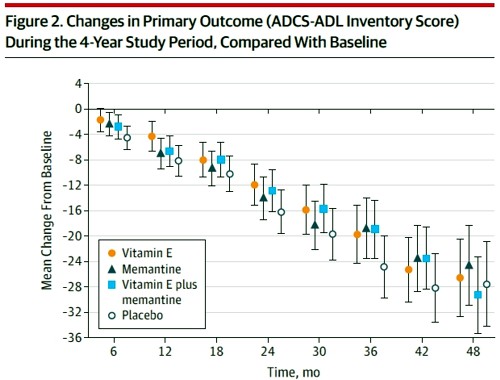
The primary outcome measure was
" . . the Alzheimer’s Disease Cooperative Study/Activities of Daily Living (ADCSADL) Inventory.12 The ADCS-ADL Inventory is designed to assess functional abilities to perform activities of daily living in Alzheimer patients with a broad range of dementia severity. The total score ranges from 0 to 78 with lower scores indicating worse function."
It looks as though any difference that might exist between the four treaments is trivial in size. In fact the mean difference between Vitamin E and placebos was only 3.15 (on a 78 point scale) with 95% confidence limits from 0.9 to 5.4. This gave a modest P = 0.03 (when properly corrected for multiple comparisons), a result that will impress only those people who regard P = 0.05 as a sort of magic number. Since the mean effect is so trivial in size that it doesn’t really matter if the effect is real anyway.
It is not mentioned in the coverage that none of the four secondary outcomes achieved even a modest P = 0.05 There was no detectable effect of Vitamin E on
- Mean annual rate of cognitive decline (Alzheimer Disease Assessment Scale–Cognitive Subscale)
- Mean annual rate of cognitive decline (Mini-Mental State Examination)
- Mean annual rate of increased symptoms
- Mean annual rate of increased caregiver time,
The only graph that appeared to show much effect was The Dependence Scale. This scale
“assesses 6 levels of functional dependence. Time to event is the time to loss of 1 dependence level (increase in dependence). We used an interval-censored model assuming a Weibull distribution because the time of the event was known only at the end of a discrete interval of time (every 6 months).”
It’s presented as a survival (Kaplan-Meier) plot. And it is this somewhat obscure secondary outcome that was used by the Journal of the American Medical Assocciation for its publicity.
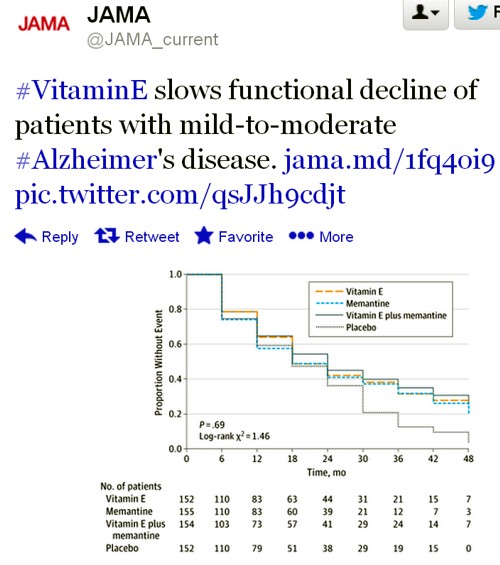
Note also that memantine + Vitamin E was indistinguishable from placebo. There are two ways to explain this: either Vitamin E has no effect, or memantine is an antagonist of Vitamin E. There are no data on the latter, but it’s certainly implausible.
The trial used a high dose of Vitamin E (2000 IU/day). No toxic effects of Vitamin E were reported, though a 2005 meta-analysis concluded that doses greater than 400 IU/d "may increase all-cause mortality and should be avoided".
In my opinion, the outcome of this trial should have been something like “Vitamin E has, at most, trivial effects on the progress of Alzheimer’s disease”.
Both the journal and the authors are guilty of disgraceful hype. This continual raising of false hopes does nothing to help patients. But it does damage the reputation of the journal and of the authors.
|
This paper constitutes yet another failure of altmetrics. (see more examples on this blog). Not surprisingly, given the title, It was retweeted widely, but utterly uncritically. Bad science was promoted. And JAMA must take much of the blame for publishing it and promoting it. |
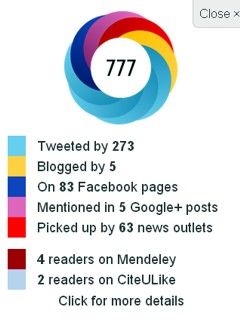
|
The bulletin of the British Pharmacological Society, Pharmacology Matters, declined to publish the following article. Sadly the Society seems to be more interested in "reputation management" than in truth. Luckily, it is not easy to suppress criticism these days. A version of the article has appeared in Research Fortnight where it will be seen by far more people than it would have been in Pharmacology Matters. This is the original version that I submitted to them. They would not allow me to quote Lewis’s comment (apropos of the sale of homeopathic meningitis vaccine)
“Children will be harmed by this inaction. Children will die. And the fault must lie with Professor Sir Kent Woods, chairman of the regulator [MHRA].”
If a child were to die of whooping cough or meningitis as a result of buying the fraudulent "vaccines", that would be true. It’s a sad reflection on the state of defamation law that journals are not willing to say so. Blogs are fast becoming the best source of reliable information.

|
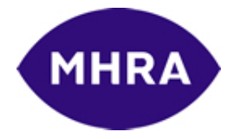
|
Stop press. The BPS has now signed up to Alltrials (too late for the printed version)
Pharmacology society does little to defend its subject
David Colquhoun
Over the past few years a courageous group of writers, researchers and activists has worked to expose the truth about the medicines we are sold, be they conventional or alternative.
Thanks, above all, to Ben Goldacre (1), more people than ever know that the big pharma companies have been concealing evidence of the harm that their products do, or the good they fail to do. Thanks to a small army of bloggers the preposterous claims made by peddlers of homeopathic remedies and other quackery are less likely to go unchallenged.
And yet, the organization charged with safeguarding the good name of pharmacology in this country, the British Pharmacological Society (BPS), has remained silent throughout.
The pharmaceutical industry
The BPS, rather than helping, became actively complicit when, along with much of the medical establishment, it signed an agreement with the ABPI (2). This document, developed under the aegis of the Ethical Standards in Health & Life Sciences Group (ESHLSG), contained two objectionable clauses:
“Industry plays a valid and important role in the provision of medical education”
And
“Medical representatives can be a useful resource for healthcare professionals”
Given that clinical “education” has long been part of Pharma’s marketing strategy, this seems disgraceful. And most of the doctors I know and respect refuse to see reps altogether. It is hopelessly optimistic to think that can an industry person can teach clinical pharmacology without bias in favour of his own company’s products. The BPS has many members who teach pharmacology. Can they really cope so badly that we need to have industry to educate clinicians?
It’s fine, and sometimes desirable, for academics and industry to work together on drug development. But only as long as the industry partner has no say in how, or whether, the results are published. Without that proviso we can expect more corruption of the sort that’s been seen at the University of Sheffield (3).
This is very sad, because I have great reason to like the drug industry. I’ve benefitted from several of their products myself. But the industry is in trouble. Many of its products provide only marginal benefits. Furthermore, some of the things that seemed to be useful, like SSRI antidepressants, have turned out to be next to useless once hidden trials were revealed (4). The MHRA’s learning module on SSRIs doesn’t seem to have caught up with this yet.
Sadly, the reaction of industry has been to resort to dishonesty, to hide unfavourable data and to increase yet more what it spends on marketing. Between 2009 and 2012, fines of at least 10 billion dollars (5) have been imposed on some of the most eminent companies. They include Lilly, Pfizer, AstraZeneca, Merck, Abbott and GlaxoSmithKline (GSK). The biggest fine of all ($3 bn, in July 2012) went to a British company, GSK. This succession of large fines seems to be regarded by the companies as mere marketing expenses.
All these fines were levied in the USA. Where, one might ask, are the regulators in the UK? Why have there been no fines here? Why, indeed, are some of the senior managers of these companies not in jail? Why has the BPS remained silent about the prostitution of its subject? And why have the MHRA done so little to stop it?
I suggest that you support the petition for release of the results of all trials (6). It’s been supported by many individuals and a lot of organisations, including the BMJ and the Royal Statistical Society. But, disgracefully, not by the BPS.
Quackery
At least in the case of the pharmaceutical industry some of its products work. But pharmacologists should also be concerned about the quackery industry, worth about 60 billion dollars per year (as opposed to $600 bn for the pharmaceutical industry). Virtually none of their products work (7). Why has the BPS said so little about it? It has, along with most of the medical and university establishment, shrugged its shoulders about the fact that students at Westminster University have been shown dowsing with a pendulum as a method for selection of herbal “remedies”, as part of a Bachelor or “Science” degree. It is an area in which every regulatory agency has failed to ensure even minimal levels of honesty (8). And the BPS has just shrugged.
The MHRA has been worse than useless in this area: it has been actively unhelpful (9). The senior staff of the MHRA are members of the BPS which has, as usual, said next to nothing. The MHRA’s herbal medicine committee has allowed misleading labels that give indications to be put on herbal potions, and these labels fail to make it clear that no evidence whatsoever of efficacy is required to get the MHRA kitemark. The wording was suggested (not required) by European law, but that law does not prevent the MHRA from saying, as it should, “there is no reason to think that this product is effective for any of the indications on the label” (10). Arguably, the MHRA is in breach of Consumer Protection law (11, 12).
At the time, the BPS did make some objection to the labelling (13), but only under great pressure from me (indeed I wrote it) . That has not been followed up, and I can no longer find it on the BPS web site. Indeed Philip Routledge, one of the people who is responsible for the misinformation in his capacity as chair of the MHRA Herbal Medicines Advisory Committee, is, at present the president of the BPS.
The MHRA has also been responsible for misleading labelling of the products of the most obviously fraudulent products of the lot: homeopathic pills, the medicines that contain no medicine. Most of the pills (anything beyond 12x dilution) contain not a single molecule of the substance on the label. Yet they have been given a get-out clause that enables them to evade prosecution by Trading Standards (an organisation that consistently fails to apply consumer protection laws. Rose et al (2011) (12) concluded
"EU directive 200s5/29/EC is largely ineffective in preventing misleading health claims for consumer products in the UK".
It is simply bizarre that the people at the MHRA, many of who are BPS members, have sat round a table and approved the following label. This example is for Arnica 30C pills, which, of course, contain no trace of arnica (14, 8). The outcome of their deliberations is simply surreal (see the actual labels here).
"Used within the homeopathic tradition for the symptomatic relief of sprains, muscular ache; and bruising or swelling after contusions."
This will deceive the naïve into thinking that it will have some effect on sprains etc. It won’t. And the MHRA have declined to test how the label is perceived by the public, though it took some effort to get them to admit it.
"If you are allergic to any of the ingredients in this medicine, consult your doctor before taking this medicine."
The ingredients aren’t stated apart from “contains lactose and sucrose”. That’s all they contain. No arnica.
"If pregnant or breastfeeding consult your doctor before use."
Why should a few mg of lactose and sucrose have the slightest effect on a pregnant or breast-feeding mother. This is pure make-believe
"If you forget to take this product, continue to take your usual dose at the usual time, it does not matter if you have missed a dose. Do not take a double dose to make up for a missed dose."
This statement is even more bizarre. There is nothing in the pills.
"If you take too much of this product (overdose) speak to a doctor or pharmacist and take this label with you."
And this is the ultimate in nonsense. The 1023 campaign regularly swallows whole bottles, and of course nothing happens. You can’t overdose on nothing. The fact that the MHRA can insist on this label, with a straight face, is the ultimate betrayal of science and reason.
"When asked to comment, as part of the consultation on these rules, this was the response from the BPS."
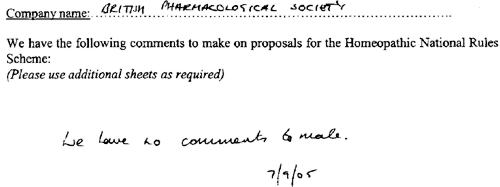
This is extracted from page 16 of the “selected response” provided by the MHRA under a Freedom of Information Act request [download all]
Things have changed little since A.J. Clark wrote his book on Patent Medicines in 1938 (15). And the BPS has done next to nothing to help. Neither has the MHRA. In fact both have colluded in the failures of both honesty and reason.
A BBC South West program recently revealed that a pharmacist was selling “homeopathic vaccines” for whooping cough and meningitis (16). The MHRA have know about his homicidal practice for years, but have done nothing. The General Pharmaceutical Council let him off with a rap on the knuckles. It has been left to bloggers and TV reporters to focus attention on these scoundrels. The well-respected blogger, Andy Lewis, wrote (17)
“Children will be harmed by this inaction. Children will die. And the fault must lie with Professor Sir Kent Woods, chairman of the regulator [MHRA].”
And the full clinical data for Tamiflu are still being concealed by Roche (18).
I think that is rather shameful.
I have been a member of the BPS for all my working life. I was happy when they made me an honorary fellow. But I now find myself asking if I can remain a member of an organisation that has done so little to defend honest scientific behaviour.
References
(1) Ben Goldacre’s Bad Pharma. Buy it now. Then do something. https://www.dcscience.net/?p=5538
(2) ABPI 2012 Guidance on collaboration between healthcare professionals and the pharmaceutical industry. http://www.abpi.org.uk/our-work/library/guidelines/Pages/collaboration-guidance.aspx
(3) Colquhoun, D. (2007) The Corporate Corruption of Higher Education: part 2 https://www.dcscience.net/?p=193
(4) Kirsch,I., B.J.Deacon, T.B.Huedo-Medina, A.Scoboria, T.J.Moore, and B.T.Johnson. 2008. Initial severity and antidepressant benefits: a meta-analysis of data submitted to the Food and Drug Administration. PLoS. Med. 5:e45. http://www.plosmedicine.org/article/info:doi/10.1371/journal.pmed.0050045
(5) Groeger, L. (2012) Big Pharma’s Big Fines http://www.propublica.org/special/big-pharmas-big-fines
(6) All trials registered. All results reported, http://www.alltrials.net/supporters/
(7) Singh,S. and E.Ernst. 2009. Trick or Treatment. Corgi. http://en.wikipedia.org/wiki/Trick_or_Treatment
(8) Colquhoun, D. (2012) Regulation of alternative medicine: why it doesn’t work, and never can. https://www.dcscience.net/?p=5562
(9) Colquhoun, D, (2006) The MHRA breaks its founding principle: it is an intellectual disgrace. https://www.dcscience.net/?p=32
(10) Colquhoun, D. (2011). Why does the MHRA refuse to label herbal products honestly? Kent Woods and Richard Woodfield tell me. https://www.dcscience.net/?p=4269
(11) Colquhoun, D. (2009) Most alternative medicine is illegal. https://www.dcscience.net/?p=30
(12) Rose,L.B., P.Posadzki, and E.Ernst. 2012. Spurious claims for health-care products: an experimental approach to evaluating current UK legislation and its implementation. Med. Leg. J. 80:13-18. https://www.dcscience.net/Rose-medico-legal-2012.pdf
(13) Colquhoun, D. (2006) Learned Societies speak out against CAM, and the MHRA. https://www.dcscience.net/?p=30
(14) MHRA Arnicare Arnica 30c pillules NR 01175/0181 http://www.mhra.gov.uk/home/groups/par/documents/websiteresources/con049307.pdf
(15) Colquhoun, D. (2008) Patent medicines in 1938 and now: A.J.Clark’s book. https://www.dcscience.net/?p=257
(16) BBC South West on the evils of homeopathic "vaccines" http://www.youtube.com/watch?v=TZf9mUzI4RI
(17) Why Does the MHRA Not Close Down these Homeopaths? The regulators have known of serious problems for years, Nothing is done. http://www.quackometer.net/blog/2013/01/why-does-the-mhra-not-close-down-these-homeopaths.html
(18) Payne, D. (2012). Tamiflu: the battle for secret drug data http://www.bmj.com/content/345/bmj.e7303
Follow-up
25 February 2013 This post has some follow-up even before it appeared on Research Research. I noticed on the BPS web site a press release “BPS announces intention to sign All Trials Petition“. It was dated 20th February, but I didn’t notice it until after the printed edition went to press. It was expressed as a future intention to sign, though in fact they signed almost straight away (though over 100 organisations had already done so). That’s good. I suspect that when my old friend, Humphrey Rang, who is president elect of the BPS, takes charge, the Society may start to take its responsibilities to the public more seriously than it has in the past.
|
The MHRA, on the other hand, is still evading its self-declared job of ensuring the public that drugs work. |
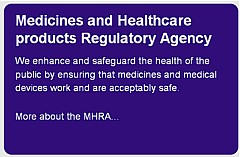
|
13 March 2013. A reply to this piece appeared in red on Research Research, The British Pharmacological Society champions its science. It was written by Humphrey Rang who, as president elect of the BPS naturally felt obliged to defend its record. He defends the BPS membership of ESHLSG, but fails to mention that first the Lancet and then the BMA withdrew their support. Nor does he mention that medical students and doctors launched a campaign, BadGuidelines.org, against the agreement. The Medical Schools Council, which also signed the agreement, said "the scrutiny of the guidance has ‘identified deficiencies in the current statement". Didn’t they read it before signing? Rang says that the BPS is also working to improve the joint statement with the ABPI. That’s good, but one must wonder why the BPS signed up to the original form.
On the points about quackery, Rang sites the BPS statement on homeopathy (now vanished) but fails to mention that that statement was written by me in an attempt to wake the BPS from it’s slumbers on the matter of medicines that don’t work. But he doesn’t mention at all the matter of mislabelling of both homeopathic and herbal preparations.
Of course, the BPS does many good things. But like most organisations, it is too reluctant to speak out when it sees wrongdoing, and too reluctant to say "sorry we made a cock-up that time".
|
This is a very important book. Buy it now (that link is to Waterstone’s Amazon don’t pay tax in the UK, so don’t use them). When you’ve read it, do something about it. The book has lots of suggestions about what to do. |
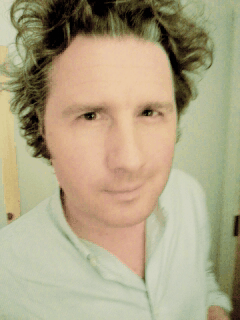
Stolen from badscience.net |
Peter Medawar, the eminent biologist, in his classic book Advice to a Young Scientist, said this.
“Exaggerated claims for the efficacy of a medicament are very seldom the consequence of any intention to deceive; they are usually the outcome of a kindly conspiracy in which everybody has the very best intentions. The patient wants to get well, his physician wants to have made him better, and the pharmaceutical company would have liked to have put it into the physician’s power to have made him so. The controlled clinical trial is an attempt to avoid being taken in by this conspiracy of good will.”
There was a lot of truth in that 1979, towards the end of the heyday of small molecule pharmacology. Since then, one can argue, things have gone downhill.
First, though, think of life without general anaesthetics, local anaesthetics, antibiotics, anticoagulants and many others. They work well and have done incalculable good. And they were developed by the drug industry.
But remember also that remarkably little is known about medicine. There are huge areas in which neither causes nor cures are known. Treatments for chronic pain, back problems, many sorts of cancer and almost all mental problems are a mess. It just isn’t known what to do. Nobody is to blame for this. Serious medical research has been going on for little more than 60 years, and it turns out to be very complicated. We are doing our best, but are still ignorant about whole huge areas. That leads to a temptation to make things up. Clutching at straws is very evident when it comes to depression, pain and Alzheimer’s disease, among others.
In order to improve matters, one essential is to do fair tests on treatments that we have. Ben Goldacre’s book is a superb account of how this could be done, and how the process of testing has been subverted for commercial gain and to satisfy the vanities of academics.
Of course there is nothing new in criticisms of Big Pharma. The huge fines levied on them for false advertising are well known. The difference is that Goldacre’s book explains clearly what’s gone wrong in great detail, documents it thoroughly, and makes concrete suggestions for improving matters.
Big Pharma has undoubtedly sometimes behaved appallingly in recent years. Someone should be in jail for crimes against patients. They have behaved in much the same way that bankers have. In any huge globalised industry it is always possible to blame someone in another department for the dishonesty. But they aren’t the only people to blame. None of the problems could have arisen with the complicity of academics, universities, and a plethora of regulatory agencies and professional bodies.
The biggest scandal of all is missing data (chapter 1). Companies, and sometmes academics, have suppressed of trials that don’t favour the drugs that they are trying to sell. The antidepressant drug, reboxetine, appeared at first to be good. It had been approved by the Medicines and Healthcare products Regulatory Agency (MHRA) and there was at least one good randomized placebo-controlled trial (RCT) showing it worked. But it didn’t. The manufacturer didn’t provide a complete list of unpublished trials when asked for them. After much work it was found in 2010 that, as well as the published, favourable trial, there were six more trials which had not been published and all six showed reboxetine to be no better than placebo . In comparisons with other antidepressant drugs three small studies (507 patients) showed reboxetine to be as good as its competitors. These were published. But it came to light that data on 1657 patients had never been published and these showed reboxetine to be worse than its rivals.
When all the data for the SSRI antidepressants were unearthed (Kirsch et al., 2008) it turned out that they were no better than placebo for mild or moderate depression. This selective suppression of negative data has happened time and time again. It harms patients and deceives doctors, but, incredibly, it’s not illegal.
Disgracefully, Kirsch et al. had to use a Freedom of Information Act request to get the data from the FDA.
“The output of a regulator is often simply a crude, brief summary: almost a ‘yes’ or ‘no’ about side effects. This is the opposite of science, which is only reliable because everyone shows their working, explains how they know that something is effective or safe, shares their methods and their results, and allows others to decide if they agree with the way they processed and analysed the data.”
|
“the NICE document discussing whether it’s a good idea to have Lucentis, an extremely expensive drug, costing well over £ 1,000 per treatment, that is injected into the eye for a condition called acute macular degeneration. As you can see, the NICE document on whether this treatment is a good idea is censored. Not only is the data on the effectiveness of the treatment blanked out by thick black rectangles, in case any doctor or patient should see it, but absurdly, even the names of some trials are missing, preventing the reader from even knowing of their existence, or cross referencing information about them.Most disturbing of all, as you can see in the last bullet point, the data on adverse events is also censored.”
|
The book lists all the tricks that are used by both industry and academics. Here are some of them.
- Regulatory agencies like the MHRA, the European Medicines Agency (EMA) and the US Food and Drugs Administration (FDA) set a low bar for approval of drugs.
- Companies make universities sign gagging agreements which allow unfavourable results to be suppressed, and their existence hidden.
- Accelerated approval schemes are abused to get quick approval of ineffective drugs and the promised proper tests often don’t materialise
- Disgracefully, even when all the results have been given to the regulatory agencies (which isn’t always). The MHRA, EMA and FDA don’t make them public. We are expected to take their word.
- Although all clinical trials are meant to be registered before they start, the EMA register, unbelievably, is not public. Furthermore there is no check that the results if trials ever get published. Despite mandates that results must be published within a year of finishing the trial, many aren’t. Journals promise to check this sort of thing, but they don’t.
- When the results are published, it is not uncommon for the primary outcome, specified before it started, to have been changed to one that looks like a more favourable result. Journals are meant to check, but mostly don’t.
- Companies use scientific conferences, phony journals, make-believe “seed trials” and “continuing medical education” for surreptitious advertising.
- Companies invent new diseases, plant papers to make you think you’re abnormal, and try to sell you a “cure”. For example, female sexual dysfunction , restless legs syndrome and social anxiety disorder (i.e. shyness). This is called disease-mongering, medicalisation or over-diagnosis. It’s bad.
- Spin is rife. Companies, and authors, want to talk up their results. University PR departments want to exaggerate benefits. Journal editors want sensational papers. Read the results, not the summary. This is universal (but particularly bad in alternative medicine).
- Companies fund patient groups to lobby for pills even when the pills are known to be ineffective. The lobby that demanded that Herceptin should be available to all on the breast cancer patients on the NHS was organised by a PR company working for the manufacturer, Roche. But Herceptin doesn’t work at all in 80% of patients and gives you at best a few extra months of life in advanced cases.
- Ghostwriting of papers is serious corruption. A company writes the paper and senior academics appear as the authors, though they may never have seen the original data. Even in cases where academics have admitted to lying about whether they have seen the data, they go unpunished by their universities. See for example, the case of Professor Eastell.
- By encouraging the funding of “continuing medical education” by companies, the great and the good of academic medicine have let us down badly.
This last point is where the book ends, and it’s worth amplification.
“So what have the great and good of British medicine done to help patients, in the face of this endemic corruption, and these systematic flaws? In 2012, a collaborative document was produced by senior figures in medicine from across the board, called ‘Guidance on Collaboration Between Healthcare Professionals and the Pharmaceutical Industry’. This document was jointly approved by the ABPI, the Department of Health, the Royal Colleges of Physicians, Nursing, Psychiatrists, GPs, the Lancet, the British Medical Association, the NHS Confederation, and so on. ”
“It contains no recognition of the serious problems we have seen in this book. In fact, quite the opposite: it makes a series of assertions about them that are factually incorrect.”
“It states that drug reps ‘can be a useful resource for healthcare professionals’. Again, I’m not sure why the Royal Colleges, the BMA, the Department of Health and the NHS Confederation felt the need to reassert this to the doctors of the UK, on behalf of industry, when the evidence shows that drug reps actively distort prescribing practices. But that is the battle you face, trying to get these issues taken seriously by the pinnacle of the medical establishment.”
This is perhaps the most shameful betrayal of all. The organisations that should protect patients have sold them out.
You may have been sold out by your “elders and betters”, but you can do something. The “What to do” sections of the book should be produced as a set of flash cards, as a reminder that matters can be improved.
It is shameful that this book was not written by a clinical pharmacologist, or a senior doctor, or a Royal College, or a senior academic. Why has the British Pharmacological Society said nothing?
It is shameful too that this book was not written by one of the quacks who are keen to defend the $60 billion alternative medicine industry (which has cured virtually nothing) and who are strident in their criticism of the 600 billion dollar Pharma industry. They haven’t done the work that Goldacre has to analyse the real problems. All they have done is to advocate unfair tests, because that is the only sort their treatments can pass.
It’s weird that medicine, the most caring profession, is more corrupt than any other branch of science. The reason, needless to say, is money. Well, money and vanity. The publish or perish mentality of senior academics encourages dishonesty. It is a threat to honest science.
Goldacre’s book shows the consequences: harm to patients and huge wastage of public money.
Read it.
Do something.
Follow-up
7 October, 2012, The Observer
Goldacre wrote
"I think it’s really disappointing that nobody, not the Royal Colleges, the Academy of Medical Sciences, the British Pharmacological Society, the British Medical Association, none of these organisations have stood up and said: selective non-publication of unflattering trial data is research misconduct, and if you do it you will be booted out. And I think they really urgently should."
Exactly.
In July 2008 I wrote an editorial in the New Zealand Medical Journal (NZMJ), at the request of its editor.
The title was Dr Who? deception by chiropractors. It was not very flattering and it resulted in a letter from lawyers representing the New Zealand Chiropractic Association. Luckily the editor of the NZMJ, Frank Frizelle, is a man of principle, and the legal action was averted. It also resulted in some interesting discussions with disillusioned chiropractors that confirmed one’s worst fears. Not to mention revealing the internecine warfare between one chiropractor and another.
This all occurred before the British Chiropractic Association sued Simon Singh for defamation. The strength of the reaction to that foolhardy action now has chiropractors wondering if they can survive at all. The baselessness of most of their claims has been exposed as never before. No wonder they are running scared. The whole basis of their business is imploding.
Needless to say chiropractors were very cross indeed. Then in February 2009 I had a polite email from a New Zealand chiropractor, David Owen, asking for help to find one of the references in the editorial. I’d quoted Preston Long as saying
"Long (2004)7 said “the public should be informed that chiropractic manipulation is the number one reason for people suffering stroke under the age of 45.”
And I’d given the reference as
7. Long PH. Stroke and spinal manipulation. J Quality Health Care. 2004;3:8–10
I’d found the quotation, and the reference, in Ernst’s 2005 article, The value of Chiropractic, but at the time I couldn’t find the Journal of Quality Healthcare. I did find the same article on the web. At least the article had the same title, the same author and the same quotation. But after finding, and reading, the article, I neglected to change the reference from J Quality Health Care to http://skepticreport.com/sr/?p=88. I should have done so and for that I apologise.
When I asked Ernst about the Journal of Quality Healthcare, he couldn’t find his copy of the Journal either, but he and his secretary embarked on a hunt for it, and eventually it was found.

![]()
|
It turns out that Journal of Quality Healthcare shut down in 2004, without leaving a trace on the web, or even in the British Library. It was replaced by a different journal, Patient Safety and Quality Healthcare (PSQH) A reprint was obtained from them. It is indeed the same as the web version that I’d read, and it highlighted the quotation in question. The reprint of the original article, which proved so hard to find, can be downloaded here. |
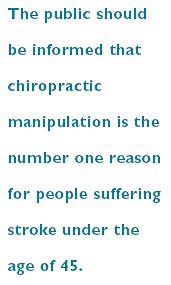
|
The full quotation is this
"Sixty-two clinical neurologists from across Canada, all certified members of the Royal College of Physicians and Surgeons, issued a warning to the Canadian public, which was reported by Brad Stewart, MD. The warning was entitled Canadian Neurologists Warn Against Neck Manipulation. The final conclusion was that endless non-scientific claims are being made as to the uses of neck manipulation(Stewart, 2003). They need to be stopped. The public should be informed that chiropractic manipulation is the number one reason for people suffering stroke under the age of 45."
I have often condemned the practice of citing papers without reading them (it is, of course, distressingly common), so I feel bad about this, though I had in fact read the paper in question in its web version. I’m writing about it because I feel one should be open about mistakes, even small ones.
I’m also writing about it because one small section of the magic medicine community seems to think they have nailed me because of it. David Owen, the New Zealand chiropractor, wrote to the editor of the NZMJ, thus.
|
The quote [in question] is the public should be informed that chiropractic manipulation is the number one reason for people suffering stroke under the age of 45. Long PH. Stroke and Manipulation. J Quality Health Care. 2004:3:8-10 This quote actually comes from the following blog article http://www.skepticreport.com/medicalquackery/strokespinal.htm [DC the URL is now http://skepticreport.com/sr/?p=88] I have attached all my personal communications with Colquhoun. They demonstrate this is not a citation error. Prof Colquhoun believes the origin of the quote doesn’t matter because Long was quoting from a Canadian Neurologists’ report (this is also incorrect). As you can see he fails to provide any evidence at all to support the existance [sic] of the “J Quality Health Care.” Colquhoun ‘s belief that my forwarding this complaint is me “resorting to threats” is the final nail in the coffin. If he had any leg to stand on where is the threat? This may seem pedantic but it surely reflects a serious ethical breach. Is it acceptable to make up a reference to try and slip any unsupported statement into a “scientific” argument and thereby give it some degree of credibility? Incidentally, at the end of the article, conflicts of interest are listed as none. As Colquhoun is a Professor of Pharmacology and much of his research funding no doubt comes from the pharmaceutical industry how can he have no conflict of interest with therapies that do not advocate the use of drugs and compete directly against the billions spent on pain medications each year? If I may quote Colquhoun himself in his defence of his article (Journal of the New Zealand Medical Association, 05-September-2008, Vol 121 No 1281) I’ll admit, though, that perhaps ‘intellect’ is not what’s deficient in this case, but rather honesty. David Owen |
Financial interests
Well, here is a threat: I’m exposed as a shill of Big Pharma. ". . . much of his funding no doubt comes from the pharmaceutical industry". I can’t count how many times this accusation has been thrown at me by advocates of magic medicine. Oddly enough none of them has actually taken the trouble to find out where my research funding has come from. None of them even knows enough about the business to realise the extreme improbability that the Pharmaceutical Industry would be interested in funding basic work on the stochastic properties of single molecules. They fund only clinicians who can help to improve their profits,
The matter of funding is already on record, but I’ll repeat it now. The media ‘nutritional therapist’, Patrick Holford, said, in the British Medical Journal
“I notice that Professor David Colquhoun has so far not felt it relevant to mention his own competing interests and financial involvements with the pharmaceutical industry “
To which my reply was
” Oh dear, Patrick Holford really should check before saying things like “I notice that Professor David Colquhoun has so far not felt it relevant to mention his own competing interests and financial involvements with the pharmaceutical industry”. Unlike Holford, when I said “no competing interests”, I meant it. My research has never been funded by the drug industry, but always by the Medical Research Council or by the Wellcome Trust. Neither have I accepted hospitality or travel to conferences from them. That is because I would never want to run the risk of judgements being clouded by money. The only time I have ever taken money from industry is in the form of modest fees that I got for giving a series of lectures on the basic mathematical principles of drug-receptor interaction, a few years ago.”
I spend a lot of my spare time, and a bit of my own money, in an attempt to bring some sense into the arguments. The alternative medicine gurus make their livings (in some cases large fortunes) out of their wares.
So who has the vested interest?
Does chiropractic actually cause stroke?
As in the case of drugs and diet, it is remarkably difficult to be sure about causality. A patient suffers a vertebral artery dissection shortly after visiting a chiropractor, but did the neck manipulation cause the stroke? Or did it precipitate the stroke in somebody predisposed to one? Or is the timing just coincidence and the stroke would have happened anyway? There has been a lot of discussion about this and a forthcoming analysis will tackle the problem of causality head-on,
My assessment at the moment, for what it’s worth, is that there are some pretty good reasons to suspect that neck manipulation can be dangerous, but it seems that serious damage is rare.
In a sense, it really doesn’t matter much anyway, because it is now apparent that chiropractic is pretty well discredited without having to resort to arguments about rare (though serious) effects. There is real doubt about whether it is even any good for back pain (see Cochrane review), and good reason to think that the very common claims of chiropractors to be able to cure infant colic, asthma and so on are entirely, ahem, bogus. (See also Steven Novella, ebm-first, and innumerable other recent analyses.)
Chiropractic is entirely discredited, whether or not it may occasionally kill people.
Complaint sent to UCL
I had an enquiry about this problem also from my old friend George Lewith. I told him what had happened. Soon after this, a complaint was sent to Tim Perry and Jason Clarke, UCL’s Director and Deputy Director of Academic Services. The letter came not from Lewith or Owen, but from Lionel Milgom. Milgrom is well known in the magic medicine community for writing papers about how homeopathy can be “explained” by quantum entanglement. Unfortunately for him, his papers have been read by some real physicists and they are no more than rather pretentious metaphors. See, for example, Danny Chrastina’s analysis, and shpalman, here. Not to mention Lewis, AP Gaylard and Orac.
|
Dear Mr Perry and Mr Clark, I would like to bring to your attention an editorial (below) that appeared in the most recent issue of the New Zealand Medical Journal. In it, one of your Emeritus Professors, David Colquhoun, is accused of a serious ethical breach, and I quote – “Is it acceptable to make up a reference to try and slip any unsupported statement into a “scientific” argument and thereby give it some degree of credibility?” Professor Colquhoun is well-known for writing extensively and publicly excoriating many forms of complementary and alternative medicine, particularly with regard to the alleged unscientific nature and unethical behaviour of its practitioners. Professor Colquhoun is also a voluble champion for keeping the libel laws out of science. While such activities are doubtlessly in accord with the venerable Benthamite liberal traditions of UCL, I am quite certain hypocrisy is not. And though Professor Colquhoun has owned up to his error, as the NZMJ’s editor implies, it leaves a question mark over his credibility. As custodians of the college’s academic quality therefore, you might care to consider the possible damage to UCL’s reputation of perceived professorial cant; emeritus or otherwise. Yours Sincerely Dr Lionel R Milgrom |
So, as we have seen, the quotation was correct, the reference was correct, and I’d read the article from which it came I made a mistake in citing the original paper rather than the web version of the same paper..
I leave it to the reader to judge whether this constitutes a "serious ethical breach", whether I’d slipped in an "unsupported statement", and whether it constitutes "hypocrisy"
Follow-up
It so happens that no sooner was this posted than there appeared Part 2 of the devastating refutation of Lionel Milgrom’s attempt to defend homeopathy, written by AP Gaylard. Thanks to Mojo (comment #2) for pointing this out.
Alfred Joseph Clark FRS held the established chair of Pharmacology at UCL from 1919 to 1926, when he left for Edinburgh. In the 1920s and 30s, Clark was a great pioneer in the application of quantitative physical ideas to pharmacology. As well as his classic scientific works, like The Mode of Action of Drugs on Cells (1933) he wrote, and felt strongly, about the fraud perpetrated on the public by patent medicine salesmen. In 1938 (while in Edinburgh) he published a slim volume called Patent Medicines. The parallels with today are astonishing.
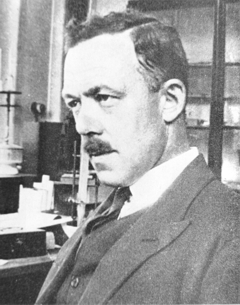 
Alfred Joseph Clark FRS (1885 – 1941) |
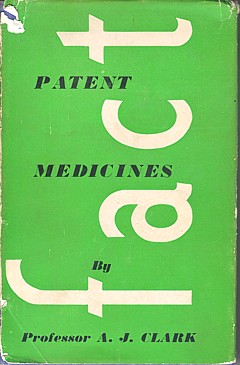 |
I was lucky to be given a copy of this book by David Clark, A.J. Clark’s eldest son, who is now 88. I visited him in Cambridge on 17 September 2008, because he thought that, as holder of the A.J. Clark chair at UCL from 1985 to 2004, I’d be a good person to look after this and several other books from his father’s library. They would have gone to the Department of Pharmacology if we still had one, but that has been swept away by mindless administrators with little understanding of how to get good science.
Quotations from the book are in italic, and are interspersed with comments from me.
The book starts with a quotation from the House of Commons Select Committee report on Patent Medicines. The report was submitted to the House on 4 August 1914, so there is no need to explain why it had little effect. The report differs from recent ones in that it is not stifled by the sort of political correctness that makes politicians refer to fraudsters as “professions”.
The problem
“2.2 The situation, therefore, as regards the sale and advertisement of proprietary medicines and articles may be summarised as follows:
For all practical purposes British law is powerless to prevent any person from procuring any drug, or making any mixture, whether patent or without any therapeutical activity whatever (as long as it does not contain a scheduled poison), advertising it in any decent terms as a cure for any disease or ailment, recommending it by bogus testimonials and the invented opinions and facsimile signatures of fictitious physicians, and selling it under any name he chooses, on payment of a small stamp duty. For any price he can persuade a credulous public to pay.”
Select Committee on Patent Medicines. 1914
“The writer has endeavoured in the present article to analyse the reasons for the amazing immunity of patent medicines form all attempts to curb their activity, to estimate the results and to suggest the obvious measures of reform that are needed.”
| Clark, writing in 1938, was surprised that so little had changed since 1914. What would he have thought if he had known that now, almost 100 years after the 1914 report, the fraudsters are still getting away with it? Chapter 2 starts thus. |
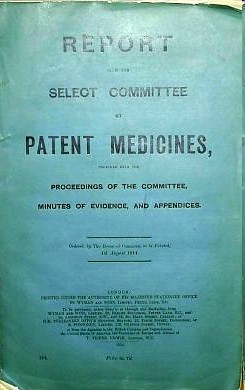 |
THE LAW
The Select Committee appointed by the House of Commons in 1914 ‘to consider and inquire into the question of the sale of Patent and Proprietary Medicines’ stated its opinion in 28 pages of terse and uncompromising invective. Its general conclusions were as follows:
That the trade in secret remedies constituted a grave and widespread public evil.
That the existing law was chaotic and had proved inoperative and that consequently the traffic in secret remedies was practically uncontrolled.
In particular it concluded ‘”that this is an intolerable state of things and that new legislation to deal with it, rather than merely the amendment of existing laws, is urgently needed in the public interest.”
The “widespread public evil”continues almost unabated, and rather than introduce sensible legislation to cope with it, the government has instead given a stamp of approval for quackery by introducing utterly ineffective voluntary “self-regulation”.
Another Bill to deal with patent medicines was introduced in 1931, without success, and finally in 1936, a Medical and Surgical Appliances (Advertisement) Bill was introduced. This Bill had a very limited scope. Its purpose was to alleviate some of the worst abuses of the quack medicine trade by prohibiting the advertisement of cures for certain diseases such as blindness, Bright’s disease [nephritis] , cancer, consumption [tuberculosis], epilepsy, fits, locomotor ataxy, fits, lupus or paralysis.
The agreement of many interests was secured for this measure. The president of the Advertising Association stated that the proposed Bill would not affect adversely any legitimate trade interest. Opposition to the Bill was, however, whipped up amongst psychic healers, anti-vivisectionists and other opponents of medicine and at the second reading in March 1936, the Bill was opposed and the House was counted out during the ensuing debate. The immediate reason for this fate was that the Bill came up for second reading on the day of the Grand National! This is only one example of the remarkable luck that has attended the patent medicine vendors.
(Page 14).
The “remarkable luck” of patent medicine vendors continues to this day, Although, in principle, advertisement of cures for venereal diseases was banned in 1917, and for cancer in 1939, it takes only a few minutes with Google to find that these laws are regularly flouted by quacks, In practice quacks get away with selling vitamin pills for AIDS, sugar pills for malaria and homeopathic pills for rabies, polio anthrax and just about anything else you can think of. Most of these advertisements are contrary to the published codes of ethics of the organisations to which the quack in question belongs but nothing ever happens.
Self-regulation simply does not work, and there is still no effective enforcement even of existing laws..
“It has already been stated that British law allows the advertiser of a secret remedy to tell any lie or make any claim that he fancies will sell his goods and the completeness of this licence is best illustrated by the consideration of a few specific points.
Advertisements for secret remedies very frequently contain a list of testimonials from medical men, which usually are in an anonymous form, stating that ………….. M.D., F.R.C.S., has found the remedy infallible. Occasionally, however, the name and address of a doctor is given and anyone unaware of the vagaries of English law would imagine that such use of a doctor’s name and professional reputation could not be made with impunity without his consent. In 1899, however, the Sallyco Mineral Water Company advertised that ‘Dr. Morgan Dochrill, physician to St. John’s Hospital, London and many of the leading physicians are presenting ‘Sallyco’ as an habitual drink. Dr. Dochrill says nothing has done his gout so much good.
Dr. Dochrill, whose name and title were correctly stated above, sued the company but failed in his case. ”
“The statement that the law does not prevent the recommending of a secret remedy by the use of bogus testimonials and facsimile signatures of fictitious physicians is obviously an understatement since it is doubtful how far it interferes with the use of bogus testimonials from real physicians.”
Dodgy testimonials are still a mainstay of dodgy salesman. One is reminded of the unauthorised citation of testimonials from Dr John Marks and Professor Jonathan Waxman by Patrick Holford to aid his sales of unnecessary vitamin supplements. There is more on this at Holfordwatch.
The man in the street knows that the merits of any article are usually exaggerated in advertisements and is in the habit of discounting a large proportion of such claims, but, outside the realm of secret remedies, the law is fairly strict as regards definite misstatements concerning goods offered for sale and hence the everyday experience of the man in the street does not prepare him for dealing with advertisements which are not merely exaggerations but plain straightforward lies from beginning to end.
Scientific training is undoubtedly a handicap in estimating popular gullibility as regards nostrums. One imagines that no one today would be willing to spend money on pills guaranteed to prevent earthquakes but yet the claims of many of the remedies offered appear equally absurd to anyone with an elementary
knowledge of physiology or even of chemistry. A study of the successes and failures suggests that success depends chiefly on not over-rating the public intelligence. (Page 34)
This may have changed a bit since A.J. Clark was writing in 1938. Now the main clients of quacks seem to be the well-off “worried-well”. But it remains as true as ever that “Scientific training is undoubtedly a handicap in estimating popular gullibility as regards nostrums.” In 2008, it is perhaps more a problem of Ben Goldacre’s dictum ““My basic hypothesis is this: the people who run the media are humanities graduates with little understanding of science, who wear their ignorance as a badge of honour.”
Clark refers (page 36) to a successful conviction for fraud in the USA in 1917. The subject was a widely advertised ‘get fat quick’ pill that contained lecithin, proteins and sugar. The BMA analysis (in 1912)
suggested that the cost of the ingredients in a box of 30 tablets sold for 4/6 was 1 1/4 d. [4/6 meant 4 shillings and six pence, or 22.5 pence since 1971, and 1 1/4 old pence, a penny farthing, is 0.52 new pence]. He comments thus.
The trial revealed many interesting facts. The formula was devised after a short consultation with the expert of one of the largest drug manufacturers in the U.S.A. This firm manufactured the tablets and sold them to the proprietary medicine company at about 3/- per 1000, whilst they were retailed to the public at the rate of £7 10s. per 1000. The firm is estimated to have made a profit of about $3,000,000.
These trials in the U.S.A. revealed the fact that in a considerable proportion of cases the ‘private formula’ department of the large and well known drug firm already mentioned had first provided the formula for the nostrum and subsequently had prepared it wholesale.
Nothing much has changed here either. The alternative medicine industry (and it is a very big industry) is fond of denouncing the evils of the pharmaceutical industry, and sadly, occasionally they are right. One of the less honest practices of the pharmaceutical industry (though one never mentioned by quacks) is buying heavily into alternative medicine. Goldacre points out
“there is little difference between the vitamin and pharmaceutical industries. Key players in both include multinationals such as Roche and Aventis; BioCare, the vitamin pill producer that media nutritionist Patrick Holford works for, is part-owned by Elder Pharmaceuticals.”
And then. of course, there is the deeply dishonest promotion by Boots the Chemists of homeopathic miseducation, of vitamins and of CoQ10 supplements.
The manner in which secret remedies can survive repeated exposure is shown by the following summary of the life history of a vendor of a consumption [tuberculosis] cure.
1904, 1906: Convicted of violating the law in South Africa.
1908: Exposed in British Medical Association report and also attacked by Truth.
1910: Sued by a widow. The judge stated: ‘I think this is an intentional and well-considered fraud. It is a scandalous thing that poor people should be imposed upon and led to part with their money, and to hope that those dear to them would be cured by those processes which were nothing but quack remedies and had not the slightest value of any kind.’
1914: A libel action against the British Medical Association was lost.
1915 The cure was introduced into the United States.
1919 The cure was sold in Canada.
1924 Articles by men with medical qualifications appeared in the Swiss medical journal boosting
the cure.
Secret remedies have a vitality that resembles that of the more noxious weeds and the examples mentioned suggest that nothing can do them any serious harm.
Most of the time, quacks get away with claims every bit as outrageous today. But Clark does give one example of a successful prosecution. It resulted from an exposé in the newspapers -wait for it -in the Daily Mail.
There is, however, one example which proves that a proprietary remedy can be squashed by exposure if this is accompanied by adequate publicity.
The preparation Yadil was introduced as an antiseptic and was at first advertised to the medical profession. The proprietor claimed that the remedy was not secret and that the active principle was ‘tri-methenal allylic carbide’. The drug acquired popularity in the influenza epidemic of 1918 and the proprietor became more and more ambitious in his therapeutic claims. The special virtue claimed for Yadil was that it would kill any harmful organism that had invaded the body. A more specific claim was that consumption in the first stage was cured with two or three pints whilst advanced cases might require a little more. Other advertisements suggested that it was a cure for most known diseases from cancer downwards.
These claims were supported by an extraordinarily intense advertising campaign. Most papers, and even magazines circulating amongst the wealthier classes, carried full page and even double page advertisements. The Daily Mail refused these advertisements and in 1924 published a three column article by Sir William Pope, professor of Chemistry in the University of Cambridge. He stated that
the name ‘tri-methenal allylic carbide’ was meaningless gibberish and was not the chemical definition of any known substance. He concluded that Yadil consisted of :
‘About one per cent of the chemical compound formaldehyde.
About four per cent of glycerine.
About ninety-five per cent of water and, lastly, a smell.
He calculated that the materials contained in a gallon cost about 1/6, whilst the mixture was sold at £4 10s. per gallon.
This exposure was completely successful and the matter is of historic interest in that it is the only example of the career of a proprietary medicine being arrested by the action of the Press.
Clark goes on to talk of the law of libel.
“On the other hand the quack medicine vendor can pursue his advertising campaigns in the happy assurance that, whatever lies he tells, he need fear nothing from the interference of British law. The law does much to protect the quack medicine vendor because the laws of slander and libel are so severe.”
The law of libel to this day remains a serious risk to freedom of speech of both individuals and the media. Its use by rogues to suppress fair comment is routine. My first encounter was when a couple of herbalists
threatened to sue UCL because I said that the term ‘blood cleanser’ is gobbledygook. The fact that the statement was obviously true didn’t deter them for a moment. The herbalists were bluffing no doubt, but they caused enough nuisance that I was asked to take my pages off UCL’s server. A week later I was invited back but by then I’d set up a much better blog and the publicity resulted in an enormous increase in readership, so the outcome was good for me (but bad for herbalists).
It was also good in the end for Andy Lewis when his immortal page “The gentle art of homoeopathic killing” (about the great malaria scandal) was suppressed. The Society of Homeopaths’ lawyers didn’t go for him personally but for his ISP who gave in shamefully and removed the page. As a result the missing page reappeared in dozens of web sites round the world and shot to the top in a Google search.
Chiropractors are perhaps the group most likely to try to suppress contrary opinions by law not argument. The only lawyers’ letter that has been sent to me personally, alleged defamation in an editorial that I wrote for the New Zealand Medical Journal. That was a little scary, but the journal stuck up for its right to speak and the threat went away after chiropractors were allowed right of reply (but we got the last word).
Simon Singh, one of the best science communicators we have, has not been so lucky. He is going to have to defend in court an action brought by the British Chiropractic Association because of innocent opinions expressed in the Guardian.
Chapter 6 is about “The harm done by patent medicines”. It starts thus.
“The trade in secret remedies obviously represents a ridiculous waste of money but some may argue that, since we are a free country and it pleases people to waste their money in this particular way, there is no call for any legislative interference. The trade in quack medicines cannot, however, be regarded as a harmless one. The Poisons Acts fortunately prevent the sale of a large number of dangerous drugs, but there are numerous other ways in which injury can be produced by these remedies.”
The most serious harm, he thought, resulted from self-medication, and he doesn’t mince his words.
“The most serious objection to quack medicines is however that their advertisements encourage self-medication as a substitute for adequate treatment and they probably do more harm in this than in any other manner.
The nature of the problem can best be illustrated by considering a simple example such as diabetes. In this case no actual cure is known to medicine but, on the other hand, if a patient is treated adequately by insulin combined with appropriate diet, he can be maintained in practically normal health, in spite of his disability, for an indefinite period. The expectation of life of the majority of intelligent diabetics, who make no mistakes in their regime, is not much less than that of normal persons. The regime is both irksome and unpleasant, but anyone who persuades diabetics to abandon it, is committing manslaughter as certainly as if he fired a machine gun into a crowded street.
As regards serious chronic disease the influence of secret remedies may be said to range from murderous to merely harmful.
‘Cures’ for consumption, cancer and diabetes may fairly be classed as murderous, since they are likely to cause the death of anyone who is unfortunate enough to believe in their efficacy and thus delay adequate treatment until too late.
The phrase “‘Cures for consumption, cancer and diabetes may fairly be classed as murderous” made Clark himself the victim of suppression of freedom of speech by lawyers. His son, David Clark, wrote of his father in “Alfred Joseph Clark, A Memoir” (C. & J. Clark Ltd 1985 ISBN 0-9510401-0-3)
“Although tolerant of many human foibles, A. J. had always disapproved fiercely of quacks, particularly the charlatans who sold fraudulent medicines. During his visits to London he met Raymond Postgate, then a crusading left wing journalist, who persuaded A.J. to write a pamphlet which was published in an ephemeral series called ‘Fact‘ in March 1938. It was a lively polemical piece. . To A.J.’s surprise and dismay he was sued for libel by a notorious
rogue who peddled a quack cure for for tuberculosis. This man said that A.J.’s remarks (such as “‘Cures’ for consumption, cancer and diabetes may fairly be classed as murderous”) were libellous and would damage his business. A.J. was determined to fight, and he and Trixie decided to put their savings at stake if necessary. The B.M.A. and the Medical Defence Union agreed to support him and they all went to lawyers. He was shocked when they advised him that he would be bound to lose for he had damaged the man’s livelihood! Finally, after much heart searching, he made an apology, saying that he had not meant that particular man’s nostrum”
Talk about déjà vu!
On page 68 there is another very familiar story. It could have been written today.
“The fact that the public is acquiring more knowledge of health matters and is becoming more suspicious of the cruder forms of lies is also helping to weed out the worst types of patent medicine advertisements. For example, in 1751 a bottle of oil was advertised as a cure for scurvy, leprosy and consumption but today such claims would not be effective in promoting the sale of a remedy. The modern advertiser would probably claim that the oil was rich in all the vitamins and the elements essential for life and would confine his claims to a statement that it would alleviate all minor forms of physical or mental ill-health.
The average patent medicine advertised today makes plausible rather than absurd claims and in general the advertisements have changed to conform with a change in the level of the public’s knowledge.
It is somewhat misleading, however, to speak of this as an improvement, since the law has not altered and hence the change only means that the public is being swindled in a somewhat more skilful manner.
The ideal method of obtaining an adequate vitamin supply is to select a diet containing an abundant supply of fresh foods, but unfortunately the populace is accustomed to live very largely on preserved or partially purified food stuffs and such processes usually remove most of the vitamins.”
The first part of the passage above is reminiscent of something that A.J Clark wrote in the BMJ in 1927. Nowadays it is almost unquotable and I was told by a journal editor that it was unacceptable even with asterisks. That seems to me a bit silly. Words had different connotations in 1927.
“The less intelligent revert to the oldest form of belief and seek someone who will make strong magic for them and defeat the evil spirits by some potent charm. This is the feeling to which the quack appeals; he claims to be above the laws of science and to possess some charm for defeating disease of any variety.
The nature of the charm changes with the growth of education. A naked n****r howling to the beat of a tom-tom does not impress a European, and most modern Europeans would be either amused or disgusted by the Black mass that was popular in the seventeenth century. Today some travesty of physical science appears to be the most popular form of incantation.”
A.J. Clark (1927) The historical aspect of quackery, BMJ October 1st 1927
Apart from some of the vocabulary, what better description could one have of the tendency of homeopaths to harp on meaninglessly about quantum theory or the “scienciness” and “referenciness” of
modern books on nutritional therapy?
So has anything changed?
Thus far, the outcome might be thought gloomy. Judging by Clark’s account, remarkably little has changed since 1938, or even since 1914. The libel law in the UK is as bad now as it was then. Recently the United Nations Human Rights Committee said UK laws block matters of public interest and encourage libel tourism (report here, see also here). It is unfit for a free society and it should be changed.
But there are positive sides too. Firstly the advent of scientific bloggers has begun to have some real influence. People are no longer reliant on journalists to interpret (or, often, misinterpret) results for them. They can now get real experts and links to original sources. Just one of these, Ben Goldacre’s badscience.net, and his weekly column in the Guardian has worked wonders in educating the public and improving journalism. Young people can, and do, contribute to the debate because they can blog anonymously if they are frightened that their employer might object.
Perhaps still more important, the law changed this year. Now, at last, it may be possible to prosecute successfully those who make fraudulent health claims. Sad to say, this was not an initiative of the UK government, which remains as devoted as ever to supporting quacks. Remember that, quite shamefully, the only reason given by the Medicines and Health Regulatory Authority (MHRA) gave for allowing false labelling of homeopathic pills was to support the “homeopathic industry”. They suggested (falsely) that the EU required them to take this irresponsible step, which was condemned by just about every scientific organisation. But the new unfair trading regulations did come from the EU. After almost 100 years since the 1914 report, we have at last some decent legislation. Let’s hope it’s enforced.
Postcript
The back cover of the series of ‘Fact‘ books in which A.J. Clark’s article appeared is reproduced below, simply because of the historical portrait of the 1930s that it gives.
Follow-up
This post got a lot of hits from Ben Goldacre’s miniblog which read
- Prof David Colquhoun gets into a time machine and meets himself
A truly classic DC post.
Thanks, Ben.
There have been some really excellent books about quackery this year. This isn’t one of them, because
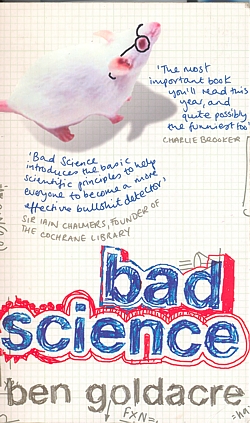 |
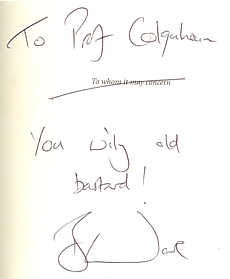
Nice dedication uh? |
it is about a lot more than quackery It is about the scientific method in general. and in particular about how often it is misunderstood by journalists. Abuse of evidence by the pharmaceutical industry is treated just as harshly as abuse of evidence by homeopaths and you get the low-down on both.
“More importantly, you will also see how a health myth can be created, fostered and maintained by the alternative medicine industry using all the same tricks on you, the public, which big pharma uses on doctors. This is about something much bigger than homeopathy.” (p.28)
Sir Iain Chalmers, a founder of the Cochrane Collaboration , co-author of the best lay text on evidence says: “Bad Science introduces the basic scientific principles to help everyone become a more effective bullshit detector”. And there is no more invaluable skill than being a bullshit detector.
Chalmers says also “Ben Goldacre has succeeded where the ‘public engagement in science’ organisations have so signally failed.” That is exactly right. ‘Public engagement’ has rapidly become bureaucratised, and at its worst, is no better than a branch of the university’s marketing department. This sort of public engagement corrupts as much as it enlightens. Goldacre enlightens, and he also makes you laugh.
In the introduction, Goldacre says
“You cannot reason people out of positions that they didn’t reason themselves into.” (p xii)
It’s a nice point, but the rest of the book makes a magnificent attempt to do just that.
There is quite a lot about medicine, of course, that’s his job, after all. But it isn’t all quackery by a long chalk Quackery is merely a good hook to hang the arguments on about how you distinguish what’s true from what isn’t. That’s partly because quacks make every mistake known to mankind (sometimes through ignorance, sometimes just to boost sales), and partly just because it is a topic that interests people, and with which they are bombarded every day I feel exactly the same. If I were to talk about the statistics of single ion channels, nobody would read it (big mistake -it’s fascinating), but if one can use the case of honey versus cough medicine to explain the analysis of variance, there is a chance that someone might find it interesting.
As much as anything, Goldacre’s book is about C.P. Snow’s two cultures. The chapters on the distortion and trivialisation of science in the media are just terrific.
“My basic hypothesis is this: the people who run the media are humanities graduates with little understanding of science, who wear their ignorance as a badge of honour. Secretly, deep down, perhaps they resent the fact that they have denied themselves access to the most significant developments in the history of Western thought from the past two hundred years.” Chapter 11, p. 207
“.. . . here is the information I would like from a newspaper to help me make decisions about my health, when reporting on a risk: I want to know who you’re talking about (e.g. men in their fifties): I want to know what the baseline risk is (e.g. four men out of a hundred will have a heart attack over ten years); and I want to know what the increase in risk is , as a natural frequency [not as relative risk] (two extra men out of that hundred will have a heart attack over ten years). I also want to know exactly what’s causing that increase in risk -an occasional headache pill or a daily tub full of pain-relieving medication for arthritis. Then I will consider reading your newspapers again, instead of blogs which are written by people who understand research , and which link reliably back to the original academic paper, so that I can double check their précis when I wish. ” (p. 242)
I detect some ambiguity in references to things that aren’t true. Sometimes there is magnanimity. At other times he is a grade one kick-ass ninja. For example
I can very happily view posh cosmetics -and other forms of quackery -as a special, self-administered, voluntary tax on people who don’t understand science properly (p. 26)
Of course nobody wants to ban cosmetics, or even homeopathy. But a lot of bad consequences flow from being over-tolerant of lies if you take it too far (he doesn’t). The lying dilemma and the training dilemma are among them. Some unthinking doctors will refer troublesome patients to a reflexologist. That gets the worried-well out of their surgery but neglects the inevitable consequence that Human Resources box-ticking zombies will then insist on having courses that teach the big toe is connected to the kidney (or whatever) so that reflexologists can have an official qualification in mystical mumbo-jumbo.
Is there anything missing from the book? Well inevitably. There are plenty of villains among the peddlers of nutri-bollocks, and in the media. But there isn’t much about the people who seem to me to be in some ways even worse. What about the black-suited men and women in the Ministry of Health and in some vice-chancellors’ chairs who betray their institutions and betray the public through some unfathomable
mixture of political correctness, scientific ignorance and greed? What about the ludicrous behaviour of quangos like Skills for Health? You have to wait right to the end of the book to hear about universities. But when it comes, it is well worth the wait.
“I’m not surprised that there are people with odd ideas about medicine, or that they sell those ideas. But I am spectacularly, supremely, incandescently unimpressed when a a university starts to offer BSc science courses in them.” (p. 317)
It’s almost worth buying Ben Goldacre’s book for that sentence alone.
This book is a romp through the folly, greed and above all the ignorance of much in our society. It’s deeply educational. And it makes you laugh. What more could you want?
The extent to which irrationality has become established in US Medicine is truly alarming I wrote about Quackademics in the USA and Canada on my last trip to the USA, and on my May trip I visited Yale, where I decided to try a full frontal attack. [download the poster]

Several US blogs have written about this phenomenon. For example the incomparable Orac at the The Academic Woo Aggregator , and Dr RW (R.W. Donnell) , see particularly his articles on How did pseudoscience get admitted to medical school? and What is happening to our medical schools? Abraham Flexner is turning over in his grave. Excellent US stuff too at Science-based Medicine (try this and this). There is also a good analysis of what’s happening at Yale by Sandy Szwarc at Junkfood Science.
Remember that the terms ‘integrative’ and ‘complementary’ are euphemisms coined by quacks to make their wares sound more respectable, There is no point integrating treatments that don’t work with treatments that do work.
‘Integrative Medicine’ at Yale says, like all the others on the roll of shame, says “we aim to improve awareness and access to the best in evidence-based, comprehensive medical care available worldwide”. They all pay lip service to being “evidence based”, but there is just one snag. It is untrue. In almost all cases, the evidence is either negative or absent. But this does not put them off for a moment. The whole process is simply dishonest.
The evidence
The evidence has been summarised in several books recently, The following books are particularly interesting because they are all ‘views from the inside. Edzard Ernst is the UK’s first Professor of Complementary Medicine. Barker Bausell was research director of an NIH funded Complementary and Alternative Medicine Specialized Research Center at the University of Maryland.
The first two books go through the evidence fairly and carefully. They show no bias against alternative treatments (if anything, I’d say they are rather generous in cases of doubt).
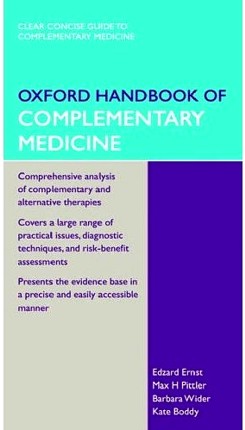 |
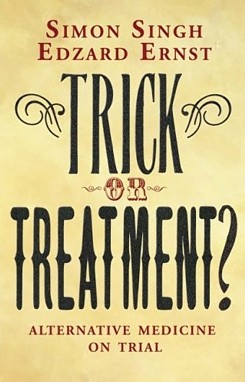 |
For a first class US account try Barker Bausell’s Snake Oil Science
Bausell’s book gives an excellent account of how to test treatments properly, and of all the ways you can be fooled into thinking something works when it doesn’t. Bausell concludes
|
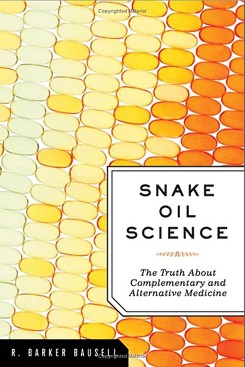 |
| For an excellent account of how to find the truth, try Testing Treatments (Evans. Thornton and Chalmers). One of the authors, Iain Chalmers, is a founder of the Cochrane library and a world authotity on how to separate medical fact from medical myth. | 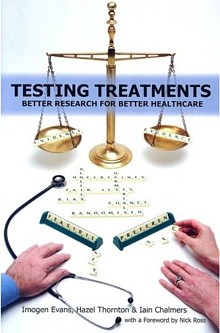 |
It can now be said with some certainty that the number of alternative treatments that have been shown to work better than placebo is very small, and quite possibly zero,
With that settled, what’s going on at Yale (and many others on the roll of shame)?
David L. Katz, MD, MPH, FACPM, FACP, is founder and director of the Integrative Medicine Center (IMC) at Griffin Hospital in Derby, Connecticut. He is also an associate professor, adjunct, of Public Health and director of the Prevention Research Center (PRC) at the Yale University School of Medicine in New Haven, Connecticut.
That sounds pretty respectable. But he is into not just good nutrition, exercise, relaxation and massage, but also utterly barmy and disproved things like homeopathy and ‘therapeutic touch’.
| Watch the movie
It so happens that Yale recently held an “Integrative Medicine Scientific Symposium”. Can we find the much vaunted evidence base there? That is easy to answer because three hours of this symposium have appeared on YouTube. So this is the public face of Yale medical school. There’s some interesting history and a great deal of bunkum and double-speak. To save you time, I’ve cut out about 6 minutes from the movies. |
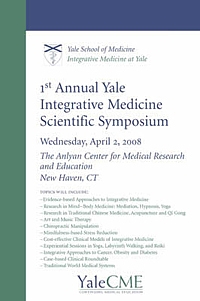 |
View or download the movie here > [18.5 Mb, flv file].
Dean of education Richard Belitsky and Dr David Katz
Pretty remarble uh? Dr Katz goes through several different trials, all of which come out negative. And what is his conclusion? You guessed.
His conclusion is not that the treatments don’t work but that we need a “more fluid concept of evidence” .
It’s equally bizarre to hear Richard Belitsky, Dean of Medical Education at Yale saying he is “very proud” of this betrayal of enlightenment values. If this is what Yale now considers to be education, it might be better to go somewhere else.
This is not science. It isn’t even common sense. It is a retreat to the dark ages of medicine when a physician felt free to guess the answer. In fact it’s worse. In the old days there was no evidence to assess. Now there is a fair amount of evidence, but Dr Katz feels free to ignore it and guess anyway. He refers to teaching about evidence as ‘indoctrination’, a pretty graphic illustration of his deeply anti-scientific approach to knowledge. And he makes a joke about having diverted a $1m grant from CDC, for much needed systematic reviews, into something that fits his aims better.
Katz asks, as one must, what should we do if there is no treatment that is known to help a patient. That is only too frequent a problem. The reasonable thing to say is “there is no treatment that is known to help”. But Dr Katz thinks it’s better to guess an answer. There is nothing wrong with placebo effects but there is everything wrong with trying to pretend that you are doing more than give placebos. Perhaps he should consider the dilemmas of alternative medicine.
You can read about more about Yale’s activities here and in interviews here. Dr Katz says “The founding approach—and I think Andrew Weil, MD, gets the lion’s share of credit for establishing the concept —is training conventional practitioners in complementary disciplines”. Let’s take a look at this hero. Try, for example, Arnold Relman’s “A trip to Stonesville“.
“According to Weil, many of his basic insights about the causes of disease and the nature of healing come from what he calls “stoned thinking,” that is, thoughts experienced while under the influence of psychedelic agents or during other states of “altered consciousness” induced by trances, ritual, magic, hypnosis, meditation, and the like.”
“To the best of my knowledge, Weil himself has published nothing in the peer-reviewed medical literature to document objectively his personal experiences with allegedly cured patients or to verify his claims for the effectiveness of any of the unorthodox remedies he uses.”
Here is the advertisment for Andrew Weil’s nutrition symposium.

Not only does this yet again propagate the great antioxidant myth, but a few moments with Google show that it is riddled with vested interests, as already pointed out on Quackademics in USA and Canada.
What has brought medical schools down to this level?
That isn’t hard to see, The main thing is simply money. Very few university administrators have the intellectual integrity to turn down money, whatever the level of dishonesty that is required by its acceptance. You can buy a lot of silence for $100m
The US Taxpayer has given almost a billion dollars, via NIH.

Wallace Sampson, MD says of NCCAM
“. . it has not proved effectiveness for any ‘alternative’ method. It has added evidence of ineffectiveness of some methods that we knew did not work before NCCAM was formed”
“Its major accomplishment has been to ensure the positions of medical school faculty who might become otherwise employed in more productive pursuits.”
“Special commercial interests and irrational, wishful thinking created NCCAM. It is the only entity in the NIH devoted to an ideological approach to health.”
NCCAM has given money from some very dubious trials too, Both Orac on Respectful Insolence and Dr RW (R.W. Donnell) have written recently about the NCCAM-funded trial of “chelation therapy”, as first exposed in a devastating article by Kimball C. Atwood IV, MD; Elizabeth Woeckner, AB, MA; Robert S. Baratz, MD, DDS, PhD; Wallace I. Sampson, MD on Medscape Today. This is a $30 million, 5-year, phase 3 Trial to Assess Chelation Therapy (TACT) for coronary artery disease.
“But how did such a crappy study ever come to be, much less be funded by the NIH to the tune of $30 million? The answer, not surprisingly, involves one of the foremost promoters of quackery in the federal government, Representative Dan Burton (R-IN).”
“We conclude that the TACT is unethical, dangerous, pointless, and wasteful. It should be abandoned.”
Orac comments
“TACT is not the only example of an unethical and scientifically worthless trial being funded not because the science is compelling but because powerful lobbies and legislators who are true believers in woo applied pressure to the NIH to do them”
The Bravewell Collaboration is the other major source of money. Forbes Business says “Bravewell is not some flaky New Age group”. Well dead wrong there, That is precisely what it is.
This group of ultra-rich people, according to its boss, Christy Mack, has a
So Bravewell is corrupting the search for real knowledge and real cures with big bucks. You can buy a lot of hokum for $100m. |
 |
The money comes from Morgan Stanley,
|
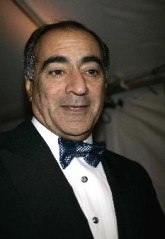 |
Bravewell is run by his wife, Christy Mack (Mack-the-wife?) Vice-President, The C.J. Mack Foundation, Member, Board of Directors, The Bravewell Collaborative.
The Flexner report.
The story of Bravewell stands in chilling contrast to another case of philanthropy. Andrew Carnegie’s foundation financed the report by Abraham Flexner, “Medical Education in the United States and Canada” (1910) [download, 15 Mb] . That report was responsible for dragging medical education out of the dark ages
almost a century ago. It resulted in creation of some of the best medical schools anywhere (including Yale).
“By educational patriotism I mean this: a university has a mission greater than the formation of a large student body or the attainment of institutional completeness, namely, the duty of loyalty to the standards of common honesty, of intellectual sincerity, of scientific accuracy.”
“The tendency to build a system out of a few partially apprehended facts, deductive inference filling in the rest, has not indeed been limited to medicine, but it has nowhere else had more calamitous consequences.”
Flexner (1910).
Now another philanthropist is using big bucks to reverse the process and push medicine back into the 19th century.
Flexner would have thought it quite inconceivable that in 2007 medical schools would be offering Continuing Medical Education in homeopathy.
Why are Yale’s academics so quiet about this?
Perhaps they don’t even know it’s happening. If they say firmly that they don’t want it, it will go,
It’s been done before
Florida State University, allegedly under political pressure, proposed to set up a school of Chiropractic. That would have made it Florida State school of snake-oil salesmanship. What a sad fate. [ Science magazine comment] [comment form Paul Lee] [Comment in St Petersburg Times]
But the academics stopped it. An FSU professor, Albert Stiegman, predicted the future campus map.
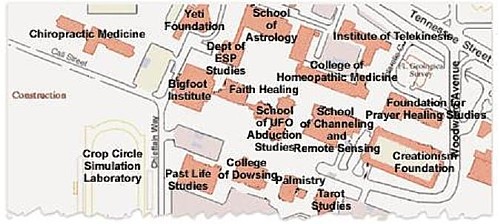
According to FSUnews
“The Florida Board of Governors voted 10-3 Thursday to deny Florida State University’s request to build a chiropractic school.”
“However, the passage of the bill for the chiropractic school by the Legislature seemingly bypassed the Board of Governors.”
In the end, reason won. Let’s hope that Yale follows their example.
Follow up
The problem of Yale has been taken up with great eloquence by some US commentators
Dr RW (R.W, Donnell): “Quackademic Medicine at Yale”
“By the way, where’s the AAMC in all this? Aren’t they supposed to be guardians of integrity and professionalism in medical education? Are they asleep at the switch or is money silencing them too?”
Orac (Respectful Insolence): “Integrative” medicine at Yale: A more “fluid” concept of evidence?”
“after the Dean of the Yale School Medicine embarrassed himself in the introduction by saying he’s proud of how far this nonsense has come, Dr. Katz takes the stage and demonstrates the sort of hostile attitude towards science that, if allowed to take root will be the death of scientific medicine in any meaningful form at U.S. medical schools”
Junkfood Science. Sandy Szwarc on “Quote of the day: ;We need a more fluid concept of evidence’”
“Will healthcare professionals and consumers . . . . speak out against these wellness programs being enacted by government agencies, insurers and employers? Or is the money too good?”
Science-based Medicine. Steven Novella writes on “Changing the rules of evidence“. When alternative medicine people do not like the evidence, they change the rules to get the outcome that they want, as seen so graphically in this post. They have always done this, but it is only recently that this sort of behaviour has been endorsed by places like Yale.
The Macho Response, another US blog, comments bluntly, in “Yale wants a more fluid concept of evidence”
This is beyond embarrassing – it’s a fucking crime – and it’s happening at Yale University and many others.
If you’re in the medical profession (and I know many of my readers are) you need to go here – now.
Kiosque Médias writes as follows
Pour ceux qui s’intéressent à la médecine et à la santé, le blog de David Colquhoun vaut probablement le détour. Ce professeur-chercheur au département de neurosciences, de physiologie et de pharmacologie de l’University College London y décrypte les résultats d’études médicales, en mettant l’accent sur les médecines alternatives. Et il est rarement tendre!
James Randi Newsletter. The hit rate soars after a recommendation this piece by the amazing Randi.
Hokum-Balderdash Assay. Edwardson writes
“Yale University is going to the ducks. It now has an Integrative Medicine program and in April held its first annual Integrative Medicine Scientific Symposium. I think there must’ve been a typo there. They must’ve meant “Ist Annual I.M. Pseudoscientific Symposium.” There! Now we’ve done away with the oxymoron.”
Why is Yale so secretive about its quackery department?,
Most universities are only to keen to boast about their grant income. Not in this case though. When I asked how they funded their quackery, all I got was a letter that had very obviously been drafted by a lawyer.
“As a private institution, Yale University is not generally subject to the U.S. Freedom of Information Act. We therefore respectfully decline to compile and provide the information you have requested.”
So pretty clear signs of guiltiness there.
Dr David Katz, yes, he of the “fluid concept of evidence”, has posted an article, Health Hazards of rhe Blogoshere. If it quacks like a duck . . .
It seems that he has been a bit alarmed by the reaction of the bloggers. It starts, rather pompously, thus.
“Being well educated does not guarantee you’ll always be right, and it certainly doesn’t guarantee everyone will agree with you. But it still matters. Or at least it used to “
But the rest if it reads less like a defence than as an admission of guilt, thus prompting the next item.
Paul Hutchinson’s blog
| A quack who admits it picks out a quotation from Dr Katz’s response and turned into a cartoon, released to the public domain, So here it is. |  |
Respectful Insolence.
Orac comments too, in “Fluid evidence” strikes back: Dr. Katz versus the skeptical blogsophere”. He does a terrific job in taking apart the response from the hapless Dr Katz.
“No, Dr. Katz does not like his first encounter with the medical blogosphere at all. Indeed, he is so unhappy that apparently a few weeks ago he tried t answer the bloggers who had raked him over the coals for blatantly advocating “integrating” unscientific woo like homeopathy with scientific medicine. Unfortunately for him, he did not do a particularly good job of it. Indeed, what most stood out as I read his rejoinder was that he does not answer a single substantive criticism leveled at his comments. Not one. Instead, he does what pretty much all woo-meisters do when criticized for shifting goalposts and appealing to other ways of knowing besides science as a means of “proving” that their preferred fairy dust works; he wraps himself in the mantle of the brave iconoclast willing to challenge accepted dogma and whines about the peons who criticized him, heaping contempt on the bloggers who had the temerity to criticize his advocacy for pseudoscience because to him they have not earned the right to criticize his (at least in his opinion, apparently) greatness in comparison to him.”
The Times Higher Education Supplement (THES) last week had a headline “Staff loyalty key to Hefce report”.
Staff loyalty is something I’m interested in, so I read on eagerly.
The article was about report from the Higher Education Funding Council for England (HEFCE). It came from their Leadership, Governance and Management Strategic Advisory Committee (dated 2-3 July 2007). [Download the report: Word format]
Well there is the first cringe already. Whenever you see the word ‘leadership’ you can bet that it means that you are going to be lectured on how to do your job by somebody who has never done it themselves. (probably somebody suffering from Siegfried delusions -in the words of Ernest Newman. an overgrown boy scout).
| No disappointment on that score. This particular sermon is being delivered not by a successful researcher. Not even by an unsuccessful researcher who has been moved up to manage the successful ones. It is being given by Ed Smith, Global Chief Operating Officer and Strategy Leader for Assurance, PricewaterhouseCoopers. | 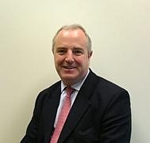 |
Their web site says of Ed Smith:
“He is a leading advocate of, and external speaker on People management in organisations, in particular diversity and work/life having led PwC’s own enlightenment in this area “
“PwC’s own enlightenment” ? Cringe!. Who writes this stuff, one wonders,
Here are the main points.
“3. There are high level activities to be undertaken of reconceptualising the university and rethinking the business model.”
Reconceptualise? Is it a condition of essential condition of working for PricewaterhouseCoopers to be unable to write plain English?
More to the point, one would be interested to know what concept of a university he has in mind? The statement as it stands has roughly zero content.
“4. To implement the outcome of this rethinking, there will need to be significant culture change. HEIs’ staff will need to be more aware of and aligned to the strategic needs of the HEI.
Academics’ goals are often related to their discipline rather than their institution and they will need to develop institutional loyalties in addition to discipline loyalties. Corporate planning processes will need to be communicated more effectively for those processes to be more successful. “
This statement fails to make the important distinction between the Institution itself, and the people who, for the time being, are running it (see Letters). The first thought that comes to mind after reading this is that it is a statement that is likely to have exactly the opposite effect from that intended by the writer. The more statements like this that come from on high, the less inclined people are to feel allegiance to the institution that issues them, or, to be more precise, the people who are running the institution for the time being.
Respect has to be earned.
“5. HE staff can find themselves uncertain about their role, typically
because it has never been fully made clear. Research has often become too prominent as an indicator of performance, because it has been measured in the RAE, and other activity has not been equally recognised and rewarded. “
Aha, now does that mean that our role is not to do research and teaching after all? Perhaps it has now been redefined somehow? Perhaps our role now is to waste time on sham consultations, read reams of world-class policy bollocks, and do what one is told by some official in HR? I don’t think so. The second sentence has some justice, but I guess Mr Smith has not had to suffer floods of contradictory instructions from the endlessly-multiplying ‘managers’.
One day a ‘manager’ says we must all publish three papers a year, and they must all be in the same handful of journals (though there has not, as far as I know, been
the sort of crude bullying about this at UCL that I have heard about in, say Imperial and a few other places). Furthermore we mustn’t collaborate with anyone in the same place because the same paper must not appear to the RAE to come from two groups.
The next day we will be told that the entire place must be turned upside down because of the absolute necessity for collaborations. Of course the measures that are proposed never have the slightest effect on collaboration, because they come from people who talk about it, not from people who do it.
And the next day we are told by a third person that all of the above is secondary and that teaching matters more than anything else.
Of course all these contradictory instructions do nothing but prevent us doing the research and teaching that we had supposed to be our job.
“7. HEIs will need to develop their business process and become more efficient, so that they can re-invest. The Committee advises that HEIs should not be afraid of the language and culture of business. “
The language of business, at least of the sort that now permeates universities, is usually both vacuous and pretentious. The culture of business is what produces BSc degrees in anti-science (not to mention accounting scandals).
The use of the word “afraid” in this context is sheer overweening arrogance. I have spent a lifetime trying to express complicated ideas in simple language. That seems to me to be as desirable in real science as it is in my attempts to improve public understanding of science. The aim of managers seems often to be to express
simple ideas in complicated language. I’m never quite sure whether the reason for this is illiteracy. or a conscious effort to disguise the emptiness of the ideas. A bit of both, I expect.
What do we conclude from this?
The interesting thing about this document is that it is written by a businessman but appears to me to ignore two basic business principles that can be put in perfectly simple language.
(1) Supply and demand. There will always be an endless supply of managers and pensioned-off researchers who are willing to accept professorial salaries for producing reams of policy bollocks. There isn’t even much shortage of people who can do a tolerable job of teaching at least at first or second year level. The really scarce people are the top flight original researchers, the ones who will make a difference to the future. It follows that these people have enormous power (though often they are too busy to use it). If the place that they works adopts the culture of managerialism, they will just leave Highly original minds have a low tolerance for policy bollocks. Of course this is a slow process. It might take a decade or more to destroy a good research outfit in this way, and by the time managers notice the consequences of their actions it would already be too late. It is much easier to destroy than to build.
(2) The value of brand names . This is where it gets personal, though I imagine many other people have had similar experiences in recent years. The Pharmacology Department at UCL has had a distinguished history for 100 years. I can’t count the number of times that I’ve been at meetings and heard people say “gosh you are from Pharmacology at UCL -that’s impressive”. People in the department got a glow from comments like that. That is what generated loyalty to the department and to the College that houses it. Now we are told that we are to be part of an over sized monstrosity called the “Research department of Neuroscience, Physiology and Pharmacology”. That really trips off the tongue, right? One can’t imagine something with an utterly unmemorable name like that ever getting an international reputation. In any case, I expect that another policy wonk will come along and change the name again in 5 year’s time,
How does this sort of vandalism happen? I guess one reason is that the sort of people who get to be managers just aren’t sufficiently in contact with science to be aware of the reputation that we used to have. They seem to be unaware that the reputation of an institution is no more than the sum of the reputations of the researchers and teachers who work in it (not the administrators). And if a department has a few good people in it over a long period, the department as a whole contributes too. The College reputation barely exists in isolation, just the sume of individuals. Take an example. At UCL we have an excellent department of German, a department that contributes to the reputation of UCL. But of course not one pharmacologist in a million has heard of it, just as I imagine not one German historian in a million has heard of our (late) pharmacology department.
Let’s get a few things clear.
- The job of universities is to do teaching and research.
- The teaching is enormously important but the external reputation of the establishment will inevitably depend almost entirely on its research.
- The success of the place therefore depends entirely on the people who do the research and teaching. Everybody else, from junior technician to vice chancellor is there only to support them.
- The people who do the research and teaching are the only ones who know how to make a success of those jobs The HR department, for example, know nothing about either either teaching or research. How could they? They have never done either. Their job is to make sure people get paid, not to bully and harass the people doing the real work of the university.
- The aims of business are, in some ways, precisely the opposite of those of universities. Business aims to sell things. Spin and mendacious advertising are an accepted part of the game. The tendency for them to become part of the game in universities too can do nothing but harm. Are universities mean to admire the mentality that gave rise to Enron and Worldcom?
- Remember the words of Robert May (President of the Royal Society, 2000 – 2005).
“A rather different issue that has emerged during the Blair decade is the tendency to invite people from the world of business to advise on the management of universities, or to head them. Given that UK universities still stand significantly higher on international league tables than does most of the UK business sector, this seems odd.”
On ‘leadership’ and ‘vision’.
The two most overworked words in management-speak remind me inexorably of the rhetoric used by those who advocated the merger of UCL and Imperial. And of two comments that appeared in the financial (not the academic) press after the attempt crumbled.
Lessons of a failed merger (Matthew Lynn, Bloomberg News. 20-Nov-02). “: [get the pdf].
“Unfortunately for Sykes, the professors of Imperial and University College London were smarter than the last recipients of his strategic wisdom, the shareholders in the formerly independent drug companies Glaxo Wellcome and SmithKline Beecham.
The biggest universities in the world are clearly not the best. So why do some British universities think that mergers will make them world class? (John Kay, 21-Nov-02 Financial Times).
” The same empty phrases that were used in the 1990s to justify corporate mergers are today used to justify university mergers – the aspiration to be a “global player”, the need to achieve “critical mass”. But greater size is always the aspiration of those with no better strategic vision.”
Two letters
These two responses appeared in THES the following week (Dec 7th), from opposite ends of the age spectrum. Notice that the younger one does not dare to give a name. I don’t blame him or her. That is the rule rather than the exception, when people feel intimidated. Exactly the same thing happened when the crazy “vision” of merging Imperial and UCL was on the cards. Anyone with half a brain could see it was nuts (with the exception of the senior management team at the time), but not everyone dared to say so.
| Loyalty, but not blind allegiance 1 Research associate, Russell Group university Published: 07 December 2007 Loyalty cuts both ways (“Staff loyalty key to Hefce report”, November 30). Look at contract research staff such as myself who are forced to seek employment in other institutions and environments. I cannot say that I have had an experience in my institution that inspires anything like loyalty. People there want it to go only one way. When are we going to get loyalty from our employing institutions rather than being treated as disposable drones? Research associate, Russell Group university. |
| Loyalty, but not blind allegiance 3 Geoffrey Alderman Published: 07 December 2007 Many years ago, it fell to me to chair Higher Education Funding Council for England teaching-quality inspections of academic departments. At one such event, the head of department confided to me and my team that he and his team completely disagreed with the strategic direction in which their vice-chancellor was taking them and were doing all they could to undermine it, in the interests of the discipline they taught. We agreed, and gave the department top marks. Geoffrey Alderman, Michael Gross professor of politics and contemporary history Buckingham University. |
Postscript
How very nice to get an endorsement from a Nobel prizewinner. Why, I wonder, was he not asked for his opinion about how to get good science. Perhaps PricewaterhouseCooper know better
This advertisement has to be one of the sneakiest bits of spin that I’ve seen in a while. It appeared in today’s Guardian. And a lot more people will see it than will look at the homeopathic nonsense on the Boots ‘education’ site.
What on earth does it mean? One interpretation could be this. We can’t make false claims for Vitamin(s) B in print, but your Boots Pharmacy Team will be happy to do so in private. OK gang, let’s find out. Get out there and ask them. I’ll be happy to post the answers you get (one of those little mp3 recorders is useful).

The Boots web site isn’t much better. Their Vitality Overview says
“The following vitamins and supplements are important for vitality..
B Vitamins
Ginkgo biloba
Ginseng
Iron
Magnesium
Vitamin C”
Needless to say “vitality” isn’t defined and there is the slightest reason to think that any of these things help the “energy level” of any person on a normal diet.
Sting number 1
I went into a large branch of Boots and asked to speak to a pharmacist. This what ensued (BP= Boots Pharmacist).
DC. My eye was caught by your advertisement. I’m pretty healthy for my age but I do get very tired sometimes and it says “ask your Boots pharmacy team, so what can you recommend?”
BP. “Well basically it helps release energy from your cells so you’ll feel more energetic if you have enough vitamin B in your, eh, blood system”
DC. “Ah, I see, I’ll feel more energetic?”
BP. “yes you’ll feel more energetic because it releases the energy from the cells ”
DC. “which vitamin B does that?”
BP. “It’s a complex. it has all the vitamins in it.”
DC. “So which one is it that makes you feel more energetic?”
BP. “Vitamin B”
DC. “All of them? ”
BP. “All of them. It’s mainly vitamin B12”
DC. “Vitamin B12. That makes you feel more energetic?”
BP. “Yes. B12 and B6.”
DC. “hmm B12 and B6. I wasn’t aware of that before so I’m a bit puzzled. I mean, vitamin B12. I thought that was for pernicious anaemia.”
At this point I think the pharmacist was getting a bit suspicious about all my questions (and spotted the recorder) and began to back off.
BP. “Not necessarily. You know its got [pause], basically what its [pause], if you have enough in your diet there’s no need to take an extra vitamin B.” . . .”This is really for people who are on the go and are, you know, unable to get fresh meals.”
Then the senior pharmacist (SP) was called and I repeated the question.
DC. “Will it give me extra energy? It says I should ask my Boots Pharmacy team about that.”
SP. “It may do, yes. It depends on your own body’s individual reaction to it.” . . . “To be honest I’m not the best person to ask about clinical data on it. If you have more detailed questions I can send them to head office”
At this point. I gave up. The first pharmacist ended up with reasonable advice, but only after she’d obviously become suspicious about all my questions (and spotted the recorder). The senior pharmacist just fudged it when asked a direct question. Initially, the ‘expert advice’ was pure gobbledygook. What does one make of it? The fact that I got the right answer in the end, one could argue, makes the first part worse rather than better. She knew the right answer, but didn’t give it straight away. Instead she talked a lot of nonsense in which two quite different meanings of the word ‘energy’ were confused in a way that is only too familiar in the supplement huckster business. I’m not impressed.
Sting number 2
An email enquiry to Boots customer service asked whether Vitamin B really helped ‘vitality’. It elicited this hilarious non-response (original spelling retained).
| Dear Mrs M*** Thank you for contacting us regarding an advertisement you have seen in relation to the benifits to vitamin C. Unfortunately as I am not medically trained I would be unable to provide you with advice on this particular product. I would however, advise that you contact our pharmacy team at your local store via the telephone directly. You’ll find that they will be more than happy to help you further. |
Aha, so the Pharmacy Team are medically-trained?
This may seem very odd to people outside the biosciences area, but in recent years a business has grown up that will write a paper for you, on the basis of data supplied by a pharmaceutical company. The person who actually did the writing will usually not appear as an author at all This practice is known as ghost writing.
It is obvious from the last two posts ( here and here ) that ghost writing of papers has became a major menace to science in the clinical world. The authors may have not even seen all of the data, and some “authors” may even not have seen the paper at all. Awareness of the size of the problem has increased, especially since the paper by Healy & Catell (2003) [ download the pdf ] (see also here ).
They say
“a process of changing scientific authorship that could conceivably culminate in a situation in which the dominant figures in therapeutics actually have comparatively little first-hand research experience and few raw data that they can share with others.”
See also “Declaration of Medical Writing Assistance in International Peer-Reviewed Publications”, Wooley et al ., 2006, JAMA, 296, 932 – 3 [get pdf ], and a Professional Ethics Report published by the American Association for the Advancement of Science.
The conversation
I recently had a conversation with a “medical writer” (don’t bother asking me who, I’m not saying). I’m very grateful that he spoke to me, because this is the sort of information that is usually concealed carefully from public view. He was clearly a person with integrity, but nonetheless what he had to say was quite disturbing. Here are some of the things that I learned.
- So called ‘Medical education agencies’ are also marketing agencies. They give expert advice to industry on how to select information from large clinical studies and how to cut and slice it to generate numerous papers. They advise on ‘publication planning’ and on which journals are best to reinforce particular messages that the companies want to convey.
- Medical writers who are acting as ‘ghost writers’ often interact with clients in the industry and don’t necessarily interact with the proposed academic authors. Opportunities to talk to the authors directly can be very limited and discussions are often mediated by a third party.
- Medical writers often do not see evidence that all authors have approved the submitted manuscript. It is perceived that only the primary author has actually approved the manuscript.
- Even if medical writers are aware of their responsibilities concerning ‘good publication practice’ and publication ethics it can be difficult to persuade clients to adopt all of these practices.
- Often medical writers do not see all of the raw data for a study or publication, they can get pre-selected data or just tables and figures for inclusion in the paper. Medical writers who are relatively inexperienced do not realise that this is not ‘best practice and will prepare a paper without requesting further background data.
- Medical writers can be pressurised by clients to include ambiguous data or marketing terms in manuscripts. When medical writers have problems with clients, support from their employers can be limited as clients are paying the bills. In this context, the ‘client’ is the company who produce the drug, not the people who eventually appear as authors.
- Ghost written papers have a number of authors. Often the most important is the primary author; this can be a selected ‘key opinion leader’ whose reputation is relied on by the company for promotion of the product.
In defence he did say that 99% of those working in the pharmaceutical industry are a pretty decent bunch. They understand that the consequences of manipulating data or employing unethical publication practices, if discovered, can be disastrous for the company and their product.
He also said that unethical publication practices occur regularly in purely academic environments. And in that he is, unfortunately, absolutely right. After all, the business of “medical writing” would not exist at all if senior academics were not willing to attach their names to papers that they have not written, and may well not even have seen all of the data.
Still worse, having been caught out doing that, they may be defended by their vice chancellors rather than condemned. Indeed anyone who dares to mention that it is going on is taking the risk of being fired. There is a shocking example here.
The Corporate Corruption of Higher Education: part 2.
| Scientists are no longer perceived exclusively as guardians of objective truth, but also as smart promoters of their own interests in a media-driven marketplace. Haerlin & Parr, Nature, 1999, 400, 499. |
University of Sheffield and Proctor & Gamble
Dr Aubrey Blumsohn MBBCh, PhD, MSc, BSc(hons), FRCPath was, until 2006, a senior lecturer and honorary consultant in metabolic bone diseases at Sheffield University. He, and his boss, Richard Eastell, were doing a clinical study of a Procter & Gamble Pharmaceuticals (P&G) drug, Actonel (risedronate), The work was funded by Procter & Gamble.
Richard Eastell is Professor of Bone Metabolism, and was Research Dean.
Proctor & Gamble refused, from 2002 onwards, to release the randomisation codes for the trial to the authors whose names appear on the paper. After trying to see the data for years, and getting little support from his employer, Blumsohn subsequently got hold of it in 2005, and then discovered flaws in the analysis provided by P&G’s statistician. P&G wrote papers on which the names of university academics as authors. Blumsohn did the only thing that any honest scientist could do: he went public with his complaint.
The result? Blumsohn has had to leave Sheffield Richard Eastell remains.
Attempts to find out what has been done by the University of Sheffield meet with silence.
Compare and contrast these two extracts (the emphasis is mine).
The first one is from Eastell, Barton, Hannon, Chines, Garnero and Delmas, 2003. (Barton and Chines were employees of Proctor & Gamble, who paid for the study). Read the full paper here
| ACKNOWLEDGMENTS We would like to acknowledge the help of Dr Simon Pack and Lisa Bosch of Procter & Gamble Pharmaceuticals, as well as the help of Oldham Hospital Clinical Chemistry Department for measuring urinary CTX and creatinine. This study was supported by grants from Procter & Gamble Pharmaceuticals, Inc. (Cincinnati, OH) and Aventis Pharma, Bridgewater, NJ. Employees of Procter & Gamble Pharmaceuticals and Aventis Pharma participated in the design and execution of the study, the analysis of the data, and the preparation of the manuscript. All authors had full access to the data and analyses. |
| In the original paper,(1) one of the authors, a statistician working for P&G (IB), had full access to all data. P&G (like most pharmaceutical companies we contacted over this issue) used the PhRMA guidelines in relation to publication of clinical trial data, and these restrict the release of original data to investigators (http://www.phrma.org/).At the time of writing (2002/03), not all the original authors were given access to the raw data. In 2006, the American Association of Medical Colleges published recommendations regarding access to raw data. These proposed that the sponsor may conduct all the analyses but that the investigators should be able to conduct their own analysis if they deem it to be necessary, and we endorse these recommendations. |
“The only thing that we have to watch all the time is our relationship with P&G. Because we are… we have the big Sheffield Centre Grant which is a good source of income, we have got to really watch it. So, the reason why I worry is the network within P&G is like lightning. So if Ian [Barton] is unhappy it goes to Arkadi [Chines, global medical director of P&G Pharmaceuticals] and before we know it, there is an issue, there is a problem.”
Just listen to the audio recording, and weep for academic integrity
More detailed accounts of this story
This is a particularly interesting case because so much information about it is now available. A particularly good edition of the BBC Radio 4 programme, You and Yours, gave a lot of the evidence. Martin Bland. Professor of Medical Statistics at York University, explains that there is actually no evidence for the plateau effect claimed by P&G and by Eastell, an effect which, if real, would allow P&G to claim that Actonel was as good as its Merk rival, Fosomax. Your can read Martin Bland’s report here.
The presenter, Vivienne Parry, concludes
“But, what it very much looks like here is that we have a company buying independent scientific expertise to give its research that veneer of credibility, only for it to withold the data generated from independent scrutiny when the results don’t suit its marketing objectives”.
Blumsohn commented thus.
“Following a protracted period of trying to contact a number of university officials to discuss this problem, I realised that raising of the problem within the university was going to prove impossible. I then engaged a lawyer and very shortly after the university suspended me from my position on the principal grounds of disobeying a supposedly reasonable mangemant instruction by communicating with the media.”
Here are some links..
- BBC Radio 4: You and Yours (2 February, 2006). ” [download realplayer file]
- Investigative Journalist, by Jennifer Washburn gave an excellent account of this whole sorry affair ” Rent-a-Researcher. Did a British university sell out to Procter & Gamble?”. It has links to many of the emails that were sent.
- Observer (4 December 2005) How the drugs giant and a lone academic went to war.
- The Alliance for Human Reserach Protection. An account from this New York-based organisation, “Scientific fraud and corruption” , and an earlier (Nov 2005) report.
- Aubrey Blumsohn’s own account, with original data and links to many sources, Proctor Research Shenanigans
- Freedom to care, “Drug Company’s Pretence“
- The Times Higher Education Supplement published a series of reports on the case. They are available only with a subscription, but click here for the latest,”Expert admits he did not have full access to data“
- A collection of media reports can be seen here.
Many of the emails make you shudder. For example, the following are extracts from an invitation to have a paper ghost-written by the Company that was sent to Eastell and Blumsohn by the company’s statistician (see the whole mail here). The emphasis is mine.
| To: r.eastell@sheffield.ac.uk, ablumsohn@sheffield.ac.uk CC: mroyer@twcny.rr.com, chines.aa@pg.com, pack.s@pg.com, david.cahall@aventis.com From: barton.ip@pg.com Date: Thu, 24 Apr 2003 14:36:41 +0100 Dear Richard and Aubrey I wanted to introduce you to one of The Alliance’s external medical writers, Mary Royer.Mary is based in New York and is very familiar with both the risedronate data and our key messages, in addition to being well clued up on competitor and general osteoporosis publications.. . .. . are you thinking of drafting the publications first and then let Mary take over or would you like Mary to write from the beginning? I’m very flexible. Mary and I have just finished writing a publication with Steven Boonen (Richard you will be contacted as you’re a co-author!) and Mary was involved at the very beginning and wrote from scratch. If you could let both Mary and I [sic] know how you envisage us all working together that would be extremely helpful. |
Why has the University of Sheffield done nothing about it?
It is one thing to find that some individuals are less than honest about reporting research. It is far more serious when the University does nothing about it. On the contrary, Sheffield effectively fired the wrong person, the person who was too honest to go along with the lies. Blumsohn eventually managed to get complete evidence, and indeed Eastell himslef, in the 2007 paper, admits that he’d lied about having complete access to the data. Yet nothing happened when Blumsohn wrote to Eastell, his Dean, his vice-chancellor or his personnel manager (the links show you the letters he sent). Because the university seemed intent on covering-up the wrongdoing, Blumsohn, very properly, did the only think that was left to him, and went to the media (e.g. THES).
This was then used by the university as an excuse to fire him.
Sheffield University has behaved abominably in this matter. And they refuse to say anything about it. After I wrote to the (new) vice-chancellor. Keith Burnett, this is what I got.
| I would like to reassure you that the University of Sheffield takes very seriously its responsibilities in the area of research integrity and always strives to act in a manner that upholds this, in accordance with its reputation. |
What can be done about corruption in universities?
Nature this week (1 Nov 2007) published an editorial, “Who is accountable“. Here are some quotations.
We suggest that journals should require that every manuscript has at least one author per collaborating research group who will go on record in a way that collectively vouches for the paper’s standards. Each would sign a statement with reference to Nature ‘s publication policies
as follows:“I have ensured that every author in my research group has seen and approved this manuscript. The data that are presented in the figures and tables were reviewed in raw form, the analysis and statistics applied are appropriate and the figures are accurate representations of the data. Any manipulations of images conform to Nature ‘s guidelines. All journal policies on materials and data sharing, ethical treatment of research subjects, conflicts of interest, biosecurity etc. have been adhered to. I have confidence that all of the conclusions presented are based on accurate
extrapolations from the data collected for this study and that my colleagues listed as co-authors have contributed and deserve the designation ‘author’.”Misconduct investigators go out of their way to spare anyone apart from the direct perpetrators, but they have indicated concerns over the degree of oversight within collaborations. If the damage to reputations were more widespread in the event of fraud, researchers would be even more fastidious about the data emanating from their labs and the due diligence they would impose. The chances of major frauds, with their disproportionate impact on the reputation of science as a whole, would be diminished.”
Wakefield, MMR and the Royal Free Hospital
This has been written about endlessly. Wakefield’s bad science has resulted in deaths from measles, and the safety of MMR has been investigated very thoroughly.
Again, the odd bad scientist is inevitable. What I would like to have seen investigated more openly is the complicity of the medical school (all this happened, thank heavens, shortly before the Royal Free Hospital Medical School became part of UCL). According to the very thorough investigation by Brian Deer:
“This “finding”, and massive publicity that the Royal Free hospital and medical school encouraged for it [through a press release , video news release and a televised press conference] launched a worldwide scare over the vaccine’s safety, triggering falls in immunisation rates, outbreaks of potentially fatal or disabling diseases, and an epidemic of unwarranted self-recrimination among parents of autistic children. ”
“Although Wakefield had performed no research upon which to credibly base such a recommendation, this attack on MMR had been orchestrated through a 20-minute video news release , prepared weeks in advance and issued to journalists by the Royal Free hospital’s press office. In this video, which doctors knew was likely to cause public alarm, and damage to immunisation rates, Wakefield four times claimed that single shots were likely to be safer than MMR, which he said should be withdrawn by the government. ”
“Unknown to the public prior to the Dispatches investigation, nearly nine months before the press conference, Wakefield and the Royal Free medical school had filed the first in a string of patent applications for extraordinary products which could only have stood any chance of success if MMR’s reputation was damaged. These included, firstly, a single vaccine against measles – a potential competitor to MMR – and, secondly, purported remedies, perhaps even what they bizarrely called a ” complete cure “, for both inflammatory bowel disease and autism. “
Follow-up
May 2005. Eastell was suspended from his NHS post after allegations that he had wrongly charged the health service for lab tests carried out for his university work outside the NHS. He resigned before a verdict could be delivered and thus escaped judgement.
November 2009 Eastell faced a General Medical Council “fitness to practice” hearing. The GMC evidently does not consider that lying in a scientific paper is misconduct (no, really). The hearing said that Eastell’s actions had not been “deliberately misleading or dishonest”, although he may have been negligent in making “untrue” and “misleading” declarations; the council did not make a finding of misconduct.. There is no "may have been", It is in print, in black and white. The GMC were utterly pusillanimous in this case. Another example of a useless regulator.
18 February 2010. A young radiologist in Sheffield, Guirong Jiang, found results which suggested that the field of osteoporosis might be distorted by the over-diagnosis of vertebral fractures (a finding that might reduce the sales of osteoporosis drugs). She was told by Eastell not to publish it. She had to go through disciplinary proceedings. Like Blumsohn, she got no support from the university: quite on the contrary. The university said her actions breached the terms of a 2007 contract with Sanofi-Aventis, an agreement that she had neither seen nor signed.
When universities behave like this it becomes hard to believe anything published by the University of Sheffield.
The Corporate Corruption of Higher Education: part 1
The next post is about examples from the UK.
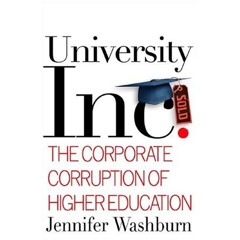 |
|
The problem in the USA came to the fore with the passage of the Bayh-Dole Act (1980). This act allowed universities to patent ‘inventions’ that came from research funded by the taxpayer, and, far worse, allowed them to grant exclusive licences to a single commercial company. Although as originally formulated the act contained safeguards, these were mostly stripped out by the time it was passed. The nominal reason for the Act was “to bring ideas out of the ivory tower and into the market place more quickly”.
Nothing wrong with that of course. But Washburn chronicles how, not only did it fail to fulfil that aim, but corrupted universities as well. In fact with only a handful of exceptions, it did not even generate any large income for the universities. Nevertheless, the Act is still in place.Here are some examples from the USA. Examples from the UK are in a separate post.
Stanford University, Garry Nolan and Rigel Pharmaceuticals
David Zapol went from MIT to be a graduate student in Stanford, in June 1996. At the time he arrived his supervisor, Garry Nolan, set up a company, Rigel Pharmaceuticals Inc. to exploit genomic screening Stanford licensed to technology exclusively to Nolan’s company.
Although the lab was meant to be separate from the Company, that was obviously impossible. Zapol, and fellow student Michael Rothenberg,. were asked by Nolan to work on “proof of concept” for Rigel’s technology. The students found that “I can;t get time with my adviser and he’s completely preoccupied” [with the company]. A year later, Rothenberg came to the lab distraught, and told Zapol he’d been at Rigel’s offices hand had seen their “proof of concept” work shown in a company presentation for investors, with no acknowldegment of their authorship. Only they and Nolan knew about the work.
Washburn comments
When I asked Nolan to to respond to Zapol’s allegations concerning Rigel’s misuse of his students’ data, he replied in writing
“I do not have a memory of this event”
The research on which the spin-off company was based was (as so often) still unproven, and the two graduate students found themselves competing with scientists in the (better-finded) company owned by their supervisor. If the latter won, the university graduate students would end up with nothing to publish.
When, in 1997, Rothenberg emailed his supervisor, Nolan, the reply he got was openly threatening
“Please, do not be referring to this situation as ‘Rigel’s inappropriate use of my data without referencing me’ “. “Be careful what you say”
In April 1997, Rothenberg (who worked in the university remember) was warned by an executive of the company, Donald Payan, not to communicate with a colleague in another university who was working in the same area.
“You should know that he is one of the founders of Selectide, a major competitor of ours . . . ” “. The guys here will be less than pleased if the ideas they give you re structures etc . . . end up in the hands of Selectide. Get my drift?”.
Stanford seems to have made few attempts to investigate the matter properly. Both graduate students left (with no peer-reviewed publications). Nolan is still there. Why is this? Stanford University (as well as Nolan) had substantial equity in Rigel (sold in 2000-01 for over $0.9m) and Stanford owned six of Nolan’s patents. What do the careers of two graduate studenst matter when there are big bucks at stake? Not much it seems.
Rigel, incidentally, has yet to produce a useful drug, eleven years after
its founding
Washburn’s book has many such examples. What is particularly upsetting about them is, in many cases, not so much the behaviour of greedy or dishonest scientists, but the behaviour of their employers. In any case where much money is at stake, the university fails to defend the honest scientists, but is more interested in its income than in truth. One has come to expect companies to behave in this way. It is a shock to see universities do the same.
GSK, Seroxat and Brown University: academics for hire, a shocking story
BBC TV’s Panorama programme showed the latest investigation of GlaxoSmithKline’s suppression of evidence of side effects of Paroxetine (Seroxat, Paxil). It seems that television journalists and lawyers have been a great deal more effective in unearthing the evidence than the regulatory authorities or the police. The MHRA has been working on the case for three years and has still not produced its report. Read the transcript here .
Lawyers in the USA managed to extract many secret emails from GSK, and they tell a sad story. Since the deregulation of industry that started around 1979 with Ronald Reagan and Margaret Thatcher, one has become accustomed to dishonesty by big business. But academics are involved too GSK organised three large scale clinical trials of Seroxat on children with depression, in the hope of getting Seroxat licensed for this use. The biggest of these is known as ‘Study 329’. It is these trials that have given rise to the charge that GSK tried to suppress evidence that Seroxat caused an increase risk of suicide in young people.
Martin Keller is chair of psychiatry at Brown University. The evidence found by Panorama also shows that his reputation seems to be for hire. His university home page shows that he holds many influential politicians. It does not mention that in one year he got half a million dollars from drug companies including GSK.In one email Keller thanks a ghost writer who worked for a PR company hired by GSK.
|
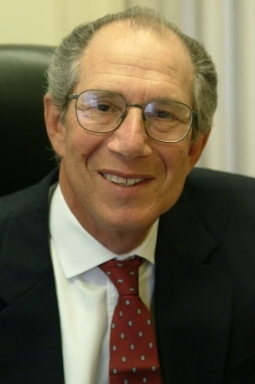 |
In another mail from the ghost writer to Dr Keller says that all the necessary materials are enclosed so that he can submit study 329 for publication, even down to the covering letter which says: “please re-type on your letterhead. Revise if you wish.”. Perhaps Keller at least checked the results carefully? But it seems not. Keller said
“I’ve reviewed data analytic tables, I don’t recall how raw it was. The huge printouts that list items by item number.. you know, item umbers, invariable numbers and don’t even have words on ’em. I tend not to look at those. I do better with words than I do with symbols.”
The BBC reporter , Shelley Jofre, comments “Inside GSK, though, the discussion was all about what a failure study 329 had been. This is what another of its PR people wrote when asked if the journal article would be publicised.” “Originally we had planned to do extensive media relations surrounding this study until we actually viewed the results. Essentially the study did not really show it was effective in treating adolescent depression which is not something we want to publicise.” [Email dated: 5th March 2001]
This is bad as any quackery, and the collusion of academics is very sad.
Brown University does not appear to have learned the lesson. The news section on their web site boasts of this ghost written work
“The largest clinical trial studying the use of antidepressants for treating major depression in adolescents suggests that paroxetine, sold under the brand name Paxil, may be successful.
“This is the first substantial evidence of a safe and effective treatment with an antidepressant for adolescents,” said Martin B. Keller, M.D., who led the study, which appears in the July issue of the Journal of the Academy of Child and Adolescent Psychiatry .”
Fiona Godlee , editor of the British Medical Journal, spoke on the programme. She had spotted the problems with the paper and declined to publish it. She comments “Another journal had peer reviewers who also spotted a number of the problems but the paper was published nonetheless relatively unchanged, and I think the journal must take some responsibility for that.”The editor of the ‘other journal’ ( Journal of the Academy of Child and Adolescent Psychiatry ) expressed no regrets.
See also “Ghost Authorship in Industry-Initiated Randomised Trials” by Gotzsche et al. ( PLOS Medicine 2007 ), and the commentary by Wagner , “Authors, Ghosts, Damned Lies, and Statisticians”. The latter concludes
“perhaps we should now admit that there are four types of lie: lies, damned lies, statistics, and the authorship lists of scientific papers, and that statisticians may be able to help prevent both the third and fourth types.”.
The British Medical Journal ran an article on “doctor bloggers” last week.
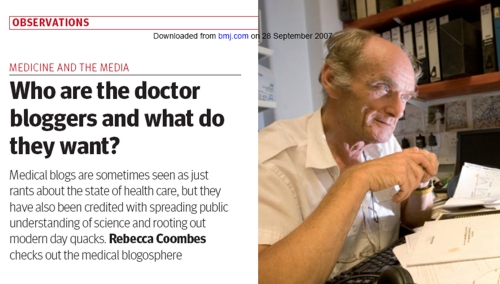
Photo ©Mark Thomas
The BMJ put the article behind a paywall, but you can download a reprint here.
Oops, no you can’t. The BMJ have dictated that their piece on bloggers should not be available to bloggers. If you want a copy, email me. The question of availability is more interesting than the article itself anyway. It is by a journalist, Rebecca Coombes. Contrary to what you might think from reading it, I have never met her. She asked for opinions by email, so I spent a while writing something out, which she cut and pasted into an article (and I spent another hour with their photographer, Mark Thomas, who took a lot of pictures). But I can’t use either the article or the photos freely. I don’t even get paid. The commercial journals, as always, do pretty well out of exploiting academics.
| The picture at the top should have been Ben Goldacre, whose badscience.net is now number two in the world. That picture prompted the child of a friend to ask if I was doing an impression of a velocirapter, I guess that is one better that gimpyblog’s perception of me as being a dead ringer for some computer game thug. So here is another one (possibly no less scary). |
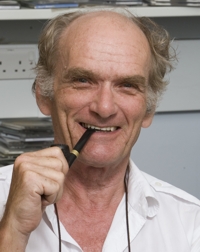
Photo ©Mark Thomas |
By way of compensation, here is a picture of Goldacre.
 Goldacre |
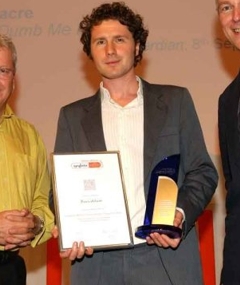 Science writer award 2005 |
Goldacre said
“. . . blogs are popular because they are more honest than other media. It is hard to get away with misrepresenting stuff when the original source is but a click away. I see it as a way of making conversation public. What is good about it is you get unmediated expertise.”
“In the press it’s hard to know what is true. But with blogs people can link directly to the original source: this never happens in a newspaper.”
DC said
“I think they [blogs] have really had some success in spreading public understanding of science and even in influencing public affairs (firstly with the merger [of Imperial and UCL] and more recently with withdrawal of NHS funding for homoeopathy). My own research is on the stochastic properties of single ion channels. I love it, but it is specialist and of zero interest to the public. So it’s fun to talk about things that do interest the public. It’s also fun to be able to influence politicians and vice chancellors, though that is rather harder.”
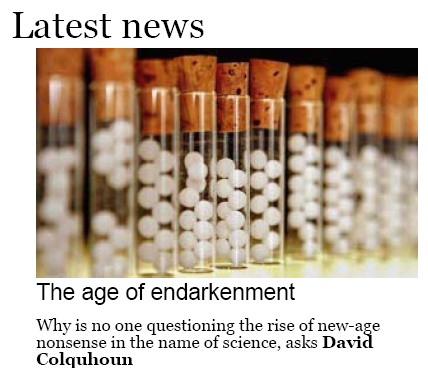
How irrational thinking in government and universities has led to the rise of new-age nonsense in the name of science.
This article appeared on 15th August 2007, on the Guardian Science web site.
The Guardian made very few cuts to the original version, but removed a lot of the links. If you want to have references to some of the claims that are made, try the original, which I reproduce here. [Download this as pdf]
The Guardian Science site also has a piece on this topic by Alok Jha: Reigniting the enlightenment How do we win back our civilisation from the jaws of darkness?
Comments can be left there too.
A German translation of this piece has been posted at the Mental health blog.
A Russian translation (draft version) has appeared here . There is also a Russian translation of How to Get Good Science which can be found here.
Etymological note. The word endarkenment has been used by several people as an antonym for the enlightenment, but the first time it caught my eye was in an article in 2005 by Gerald Weissman, The facts of evolution: fighting the Endarkenment. The article opens thus.
“Those of us who practice experimental science are living in the best of times and the worst of times, and I’m not talking about A Tale of Two Cities, but a tale of two cultures.”
Science in an Age of Endarkenment
“Education: Elitist activity. Cost ineffective. Unpopular with Grey Suits. Now largely replaced by Training.” Michael O’Donnell, in A Sceptic’s Medical Dictionary (BMJ publishing, 1997).
The enlightenment was a beautiful thing. People cast aside dogma and authority. They started to think for themselves. Natural science flourished. Understanding of the real world increased. The hegemony of religion slowly declined. Real universities were created and eventually democracy took hold. The modern world was born. Until recently we were making good progress. So what went wrong?
The past 30 years or so have been an age of endarkenment. It has been a period in which truth ceased to matter very much, and dogma and irrationality became once more respectable.
This matters when people delude themselves into believing that we could be endangered at 45 minute’s notice by non-existent weapons of mass destruction.It matters when reputable accountants delude themselves into thinking that Enron-style accounting is acceptable.
It matters when people are deluded into thinking that they will be rewarded in paradise for killing themselves and others.
It matters when bishops attribute floods to a deity whose evident vengefulness and malevolence leave one reeling. And it matters when science teachers start to believe that the earth was created 6000 years ago.
These are serious examples of the endarkenment mentality, but I’ll stick with my day job and consider what this mentality is doing to science.
One minor aspect of the endarkenment has been a resurgence in magical and superstitious ideas about medicine. The existence of homeopaths on the High Street won’t usually do too much harm. Their sugar pills contain nothing. They won’t poison your body; the greater danger is that they poison your mind.
It is true that consulting a homeopath could endanger your health if it delays proper diagnosis, or if they recommend sugar pills to prevent malaria, but the real objection is cultural. Homeopaths are a manifestation of a society in which wishful thinking matters more than truth; a society where what I say three times is true and never mind the facts.
If this attitude were restricted to half-educated herbalists and crackpot crystal gazers, perhaps one could shrug it off. But it isn’t restricted to them. The endarkenment extends to the highest reaches of the media, government and universities. And it corrupts science itself.
Even respectable newspapers still run nonsensical astrology columns. Respected members of parliament seem quite unaware of what constitutes evidence. Peter Hain (Lab., Neath) set back medicine in Northern Ireland. David Tredinnick (Cons., Bosworth) advocated homeopathic treatment of foot and mouth disease. Caroline Flint condoned homeopathy, and Lord Hunt referred to ‘psychic surgery’ as a “profession” in a letter written in response to question by a clinical scientist
Under the influence of the Department of Health, normally sane pharmacologists on the Medicines and Health Regulatory Authority, which is meant to “ensure the medicines work”, changed the rules to allow homeopathic and herbal products to be labelled, misleadingly, with “traditional” uses, while requiring no evidence to be produced that they work.
Tony Blair himself created religiously-divided schools at a time when that has never been more obviously foolish, and he defended in the House of Commons, schools run by ‘young-earth creationists‘, the lunatic fringe of religious zealots. The ex-Head Science teacher at Emmanuel College said
“Note every occasion when an evolutionary/old-earth paradigm . . . is explicitly mentioned . . . we must give the alternative (always better) Biblical explanation of the same dataâ€:
That is not from the fundamentalists of the southern USA, but from Gateshead, UK.
The Blairs’ fascination with pendulum wavers, crystals and other new age nonsense is well known. When their elders set examples like that, is it any surprise that over 30% of students in the UK now say they believe in creationism and “intelligent design”? As Steve Jones has pointed out so trenchantly, this makes it hard to teach them science at all. Welcome back, Cardinal Bellarmine.
Homeopaths and herbalists may be anti-science but they are not nearly as worrying as the university vice-chancellors who try to justify the giving of bachelor of science degrees in subjects that are anti-science to their core. How, one may well ask, have universities got into the embarrassing position of having to answer questions like that?
Here are a couple of examples of how. The University of Bedfordshire (in its previous incarnation as the University of Luton) accredited a Foundation Degree course in ‘nutritional therapy’, at`the Institute of Optimum Nutrition (IoN). The give-away is the term Nutritional Therapy . They are the folks who claim, with next to no evidence, that changing your diet, and buying from them a lot of expensive ‘supplements’, will cure almost any disease (even AIDS and cancer).
The IoN is run by Patrick Holford, whose only qualification in nutrition is a diploma awarded to himself by his own Institute. His advocacy of vitamin C as better than conventional drugs to treat AIDS is truly scary. His pretensions have been analysed effectively by Ben Goldacre, and by Holfordwatch.. See the toe-curling details on badscience.net .
The documents that relate to this accreditation are mind-boggling. One of the recommended books for the course, on “Energy Medicine” (a subject that is pure fantasy) has been reviewed thus.
“This book masquerades as science, but it amounts to little more than speculation and polemic in support of a preconceived belief.”.
The report of Luton’s Teaching Quality and Enhancement Committee (May 24th 2004) looks terribly official, with at least three “quality assurance” people in attendance. But the minutes show that they discussed almost everything about the course apart from the one thing that really matters, the truth of what was being taught. The accreditation was granted. It’s true that the QAA criticised Luton for this, but only because they failed to tick a box, not because of the content of the course.
The University of Central Lancashire ‘s justification for its BSc in Homeopathic Medicine consists of 49 pages of what the late, great Ted Wragg might have called “world-class meaningless bollocks”. All the buzzwords are there “multi-disciplinary deliveryâ€, “formative and summative assessmentâ€, log books and schedules. But not a single word about the fact that the course is devoted to a totally discredited early 19th century view of medicine. Not a single word about truth and falsehood. Has it become politically incorrect to ask questions like that? The box-ticking mentality is just another manifestation of the endarkenment thought. If you tick a box to say that you are fully-qualifed at laying-on-of-hands, that is good enough. You have done the course, and it is irrelevant whether the course teaches rubbish.
These examples, and many like them, result, I believe from the bureaucratisation and corporatisation of science and education. Power has gradually ebbed away from the people who do the research and teaching, and become centralised in the hands of people who do neither.
The sad thing is that the intentions are good. Taxpayers have every right to expect that their money is well spent, and students have every right to expect that a university will teach them well. How, then, have we ended up with attempts to deliver these things that do more harm than good?
One reason is that the bureaucrats who impose these schemes have no interest in data. They don’t do randomised tests, or even run pilot schemes, on their educational or management theories because, like and old-fashioned clinician, they just know they are right. Enormous harm has been done to science by valuing quantity over quality, short-termism over originality and, at the extremes, fraud over honesty. Spoofs about the pretentiousness and dishonesty of some science, like that published in The New York Times last year, are too close to the truth to be very funny now.
Science, left to itself, and run by scientists, has created much of the world we live in. It has self-correcting mechanisms built in, so that mistakes, and the occasional bit of fraud, are soon eliminated. Corporatisation has meant that, increasingly, you are not responsible to your conscience, just to your line manager. The result of this, I fear, is a decrease in honesty, and in the long run inevitably a decrease in quality and originality too.
If all we had to worry about was a few potty homeopaths and astrologers, it might be better to shrug, and get on with trying to find some truths about the world. But now the endarkenment extends to parliament, universities and schools, it is far too dangerous to ignore.

